 By Pepper Parr By Pepper Parr
August 17th, 2020
BURLINGTON, ON
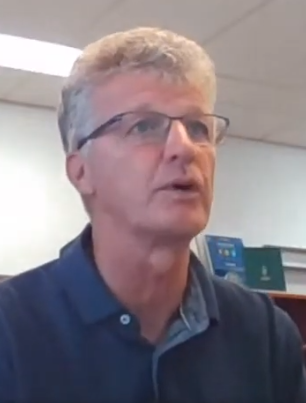 Director of Education for the Halton District School Board (HDSB), Stuart Miller The Director of Education for the Halton District School Board (HDSB), Stuart Miller, is hunkered down with his staff at the Education Centre on Guelph Line in Burlington, taking part in a meeting that has them all in the same large room.
This is a group that will be very strict in the way people in the room social distance and wear masks.
They are there to figure out how they can handle the opening of the schools on September 8th.
It is not going to be an easy task.
The province has set out requirements that many feel are just plain wrong – but school boards have to do what the Ministry tells them to do.
The government wants students back in classroom and has directed that elementary schools operate just the way they did before the schools were closed in March.
Secondary students will spend some time in a classroom and some time working from their homes being taught synchronically by their teacher who will be in the school.
Last week the Board of Education sent a note to every parent asking what they planned to do with their children: were they going to have them attend classes or were they going to keep them at home?
As of last Thursday just over 50% of the parents had responded. The responses were supposed to have been returned by last Friday – that deadline has been extended.
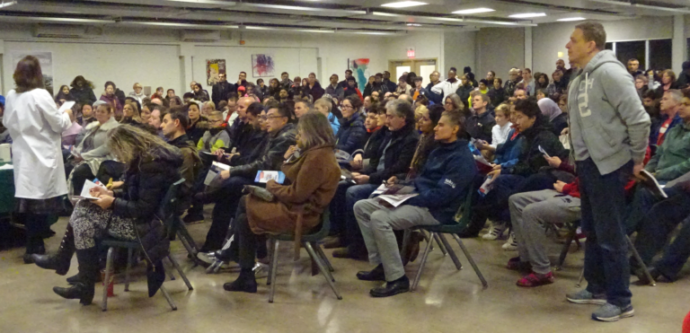 When parents have questions they show up in droves with their hands in the air. This parents meeting took place at Aldershot High school when the iStem program was announced. Directors of Education across the province are close to being totally fed up by the way the Ministry of Education is handling the delivery of education to students.
Of the 50% that did respond 81% of the parents of elementary students said they would return; 86% of the secondary parents said their children would return.
There are roughly 45,000 elementary school students being taught by the HDSB and roughly 19,000 secondary students.
The 50% of the parents that answered the survey as soon as they got it were pretty sure as to what they wanted to do – it is reasonable to assume that the other 50% were not certain.
If you do the math – you get a sense as to the size of the problem the HDSB administration is up against.
To get some sense as to what teachers are going to have to deal with. There are elementary schools in the system that have enrollments of 1200 students – Oakville and Milton have elementary schools that big.
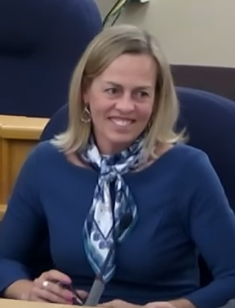 Superintendent Terri Blackwell has led the development of the program for secondary school students during the pandemic.  Scott Podrebarac has led the program for elementary school students. Both Podrebarac and Blackwell are supported by a team of senior people How does one keep the required control over 1,200 students – ensuring that they are wearing masks; ensuring that they stay within their cohort, ensuring that they don’t mix with students from other cohorts?
The HDSB has had a schedule of the condition of the HVAC systems in every school in the Region.
More than four months ago HDSB asked for permission to use some of the $40 million in the Board’s Reserve Fund account to upgrade the HVAC systems. They didn’t get a response; they were told that they could allocate $6 million from the reserve fund account to purchase the PPE supplies that would be needed.
Some school Boards, Toronto in particular, are pushing the province to permit staggered classroom openings. Nothing positive yet from the province.
The Province also said that 500 nurses were going to be hired and made available to the school districts. Nothing yet on who will be overseeing those nurses and how they will interact with the individual schools.
Will those nurses be assigned to specific schools or will they be assigned to the Public Health unit they are within?
What will a school do if they find they have an infected student? Close the class and send everyone home for 14 days or shutdown the whole school?
How will busing students to school be handled? Will there be enough drivers?
Miller expects today’s meeting to last all day and points out that most of his staff have worked every weekend since the lockdown took place in March. “This is a tremendous administrative task” adding that “there are more questions than answers – we are going to have to make things up on a daily basis. It is going to be a challenge.”
The trustees will meet for a virtual meeting on Wednesday.

 By Staff By Staff
August 17th, 2020
BURLINGTON, ON
Peter Bowker tells us that the “Burlington Centre Lions Farmers Market is a “Roaring Success” – but will need volunteers.”
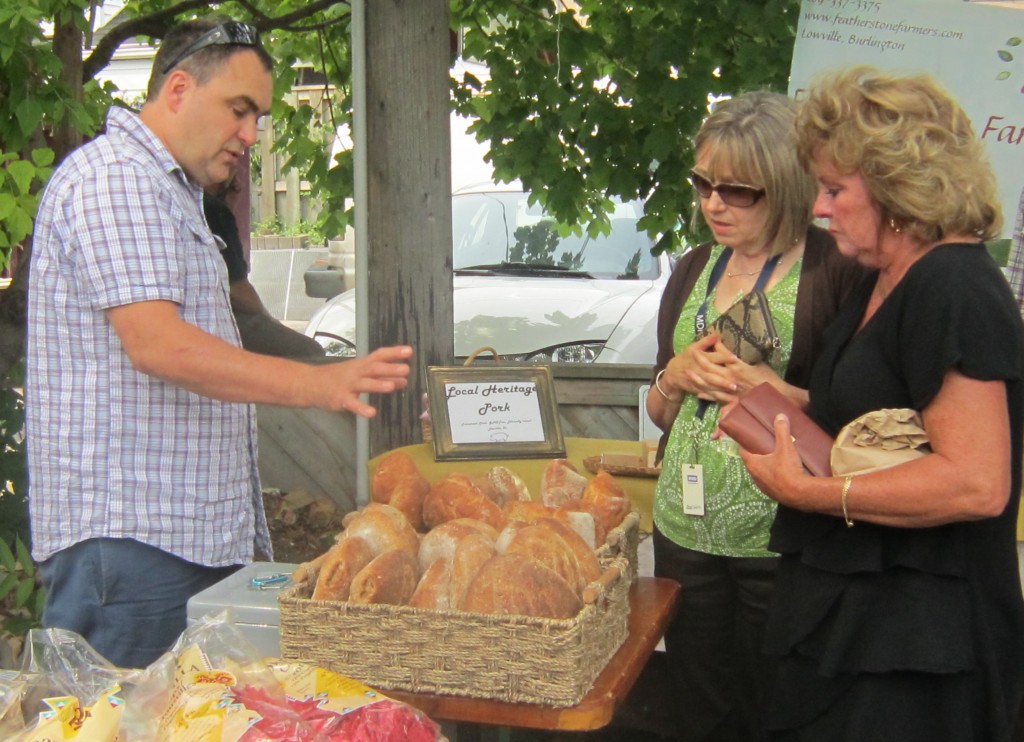 This is what a Farmer’s Market is all about. People buying fresh goods from the people who made them. The Market has now been open for ten weeks under strict COVID safety precautions – it was one of the first small businesses in the area to do so. Each week, over 40 vendors set up at the crack of dawn on Wednesday, Friday, and Saturday to offer a wide range of fresh agricultural products.
So far, over 55,000 customers have come to shop, and gone away smiling. The vendors and their staff are pleased to be able to offer their services and earn a living.
This is the 62nd consecutive year for the summer market. Over that time, nearly $1 million dollars has been raised through stall rental fees and donated by the Lions to local youth, health, and wellness needs in Burlington and area.
 This year, Burlington Lions Club invested over $4,000 in boundary fencing, signage, PPEs, sanitizers, and access controls to obtain clearance from public health authorities to operate this unique open-air venue. This cost has not been passed on to the vendors or the customers – the Lions consider it an important investment, as a service to the community. Also, additional volunteer staffing has been required to set up and take down the market, and monitor safe distancing practices of vendors and staff. This year, Burlington Lions Club invested over $4,000 in boundary fencing, signage, PPEs, sanitizers, and access controls to obtain clearance from public health authorities to operate this unique open-air venue. This cost has not been passed on to the vendors or the customers – the Lions consider it an important investment, as a service to the community. Also, additional volunteer staffing has been required to set up and take down the market, and monitor safe distancing practices of vendors and staff.
That is where needing help comes in. “We have been grateful for a number of young people who have helped through the summer, but they will leave to return to classes. So we are in need of half a dozen new volunteers to contribute a few hours each week.
“Either an hour in a morning to help set up, or an hour in the afternoon to put away, or a two-hour shift during the day monitoring customers in and out.
“Anyone interested should send a note to lionsecretary@lions14925.org, or contact Lion Jim McLaughlin at 905-536-8817.”
Related news story:
How the Farmer’s Market is set up in a Covid19 world

 By Pepper Parr By Pepper Parr
August 16, 2020
BURLINGTON, ON
From out of the blue – a few words from Bryana Cosgrove:
“Guess what’s NOT cancelled this year…not even COVID can stop something as wonderful as the Terry Fox run! But, the format is a little different. There are at least 2 ways for you to participate:
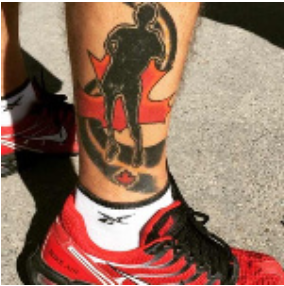 Recognize this ankle ? You should. 1. For all you cyclists out there, there is a 40th anniversary event happening on Aug 22nd where you can ride your favourite route to contribute to the collective goal of cycling 40,000kms (the circumference of the world) on that one day. If you’re interested, DM me for details on how to register and log your kms!
 Some things never die – they aren’t supposed to. 2. Team Casey will be creating our own fun event you can complete individually or in teams of people within your COVID bubble. This event can be done on your own time and in your own way…details to follow!
Through Casey’s 7 year battle with late stage lung cancer, he bounced between various treatments, but the most successful treatment was a clinical trial for a drug that was partly funded by research dollars raised by the Terry Fox Foundation. This drug gave Casey an additional wonderful three years with his friends and family, and for that we are forever grateful. Please help me pay it forward for others by supporting Team Casey.
Click the link below to become part of our team or to donate
To donate under a specific team member just click on their name on the team page.
The web site is HERE

 By Pepper Parr By Pepper Parr
August 14th, 2020
BURLINGTON, ON
So how deep is the financial hole going to be?
The city treasurer put some numbers on the table – they don’t look all that good.
Earlier in the week the City got a big chunk of money from the federal and provincial governments. More than $4 million was to cover some of the costs of running the City.
Revenue has been low – mostly from the Parks and Recreation services the City provides.
Here is what Joan Ford, City Treasurer gave Council on Thursday.
The city has been very generous on the time people have to pay their taxes. There have been deferrals on due dates – which can get a little confusing. The Table below shows what the shortfall is on the April tax levy.
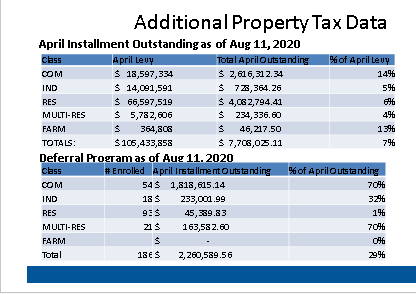
There is a total of $7, 708,000 + outstanding from the April tax levy. A number of people and organizations enrolled in the Tax deferral the city put in place. That amount comes in at $2,260,000 +
Ford set out for Council what all this was doing to cash flow. The table below shows the Cash flow projections that were in place for the 2018/2019 fiscal year and what Ford and her staff think the projection will be for 2020.
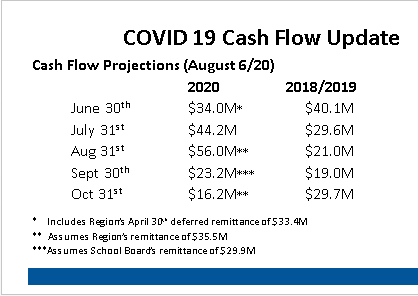
Using the data they have the Finance people set out the estimated revenue loss from tax supported and non-tax supported programs – then added to that what they expect to have to spend on COVID-19 matter. Ford told Council that to date the City has spent about $400,000 on Covid-19 tasks.
Seven million was saved on what they called “expenditure restraint”. Unless it was absolutely necessary – funds were not spent even though they were in the budget.
That still leaves a shortfall of $7,743,834.

Standing back from the detail and looking at the bigger picture – where is the pain? Parks and Recreation. Transit, the orange marker wasn’t as deep but substantial nevertheless The service was offered free of charge. That changes in September but at this point the transit people have no idea what revenue might look like.
The Parks and Recreation revenue losses were a surprise.
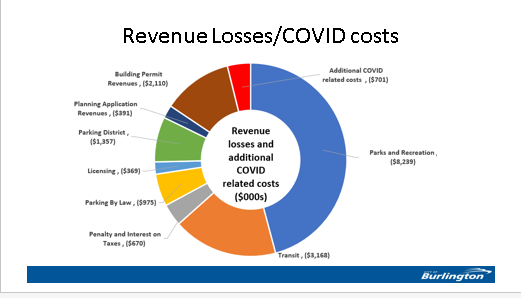
The city let all the part time people go shortly after the Emergency legislation was passed. Discretionary spending was cut and almost $3.2 million was saved in other “Business as Usual” expenses.
There is only so much that can be squeezed out of a budget. Also there are found expenses that occur the moment you turn the lights on.
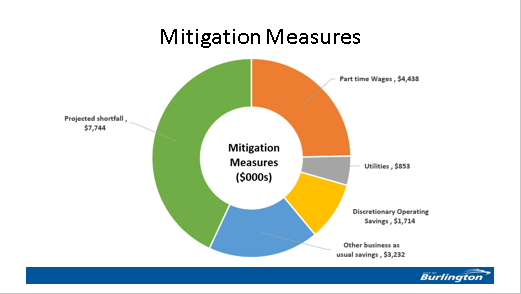
There is a very bright and tough minded crew of people who look at the services that are provided and ask: How can we redesign this service so that the public gets what they expect and we can be more efficient.
The most recent re-design resulted in an additional $1.7 (almost $1.8) million being added. Some savings with leaf collection – always a contentious issue in Burlington – were made.
That now has the shortfall at $9,541 + million.
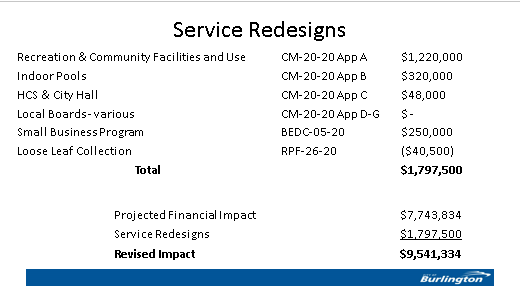
Getting a handle on the damage COVID-19 is doing to the City’s finances in a situation that is both dynamic and fluid leaves the city with what cannot be described as a pretty picture.
The finance people know that things will not remain the same – normal is no longer a state of affairs that can be seen as certain.
The Finance department did a sensitivity analysis. Starting with what they see happening now that we are into Stage 3 they looked forward and did a calculation based on an additional 5% revenue loss and then a 10% revenue loss.
Those numbers are set out below.
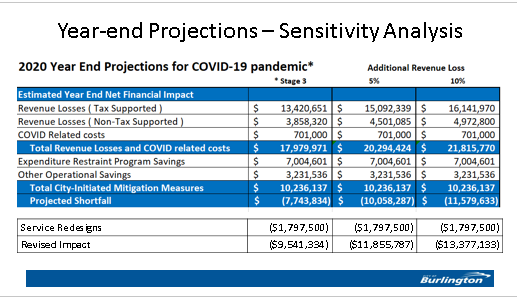
Members of City Council need now to take those projections to bed with them and think long and hard: Are they ready to tell the public that there is going to be a $13 million revenue loss. If they have to make that kind of a statement they had better have some solutions and not just assume that a tax hike will cover that off.
City Council might be approaching that point of desperation that many in the commercial, especially the hospitality sector, are experiencing. City’s cannot go bankrupt nor can they run a deficit. Should they reach that point the province sends in regulators who take over. That’s when a staff reduction is given a hard close look.

 By Staff By Staff
August 14th, 2020
BURLINGTON, ON
For those who want to get deeply into the weeds on just what the province is telling the school boards what they are required to do the Memorandum from the Ministry to the Boards wiill be interesting.
Purpose
The Ministry of Education is committed to ensuring that students1 across Ontario receive a consistent approach to remote learning in times of extended interruption to conventional in-person learning, such as when public health emergencies, pandemics, natural disasters, or other unplanned events force the closure of classrooms or schools.
This memorandum provides direction to school boards2 on remote learning requirements, including implementation and reporting. This memorandum also identifies effective practices that school boards should develop to support students during remote learning.
 Classes like this will be difficult to hold. During full or partial school closures, or under any other periods of remote learning, it is crucial to keep students engaged in their learning. Students should have access to a school community, a support network, and authentic educational experiences in order to continue to progress in their learning.
This memorandum must be implemented in alignment with collective agreements. Where there is a conflict between the memorandum and a collective agreement, the collective agreement must prevail.
Definitions of “Remote”, “Synchronous”, and “Asynchronous” Learning
In the context of this memorandum, “remote learning”, “synchronous learning”, and “asynchronous learning” mean the following:
Remote learning: Learning that occurs when classes are taught at a distance and when students and educators are not in a conventional classroom setting. Remote learning takes place in times of extended interruption to in-person learning – for example, as a result of a pandemic or natural disaster. Classes can be synchronous or asynchronous and can be taught online through a Learning Management System (LMS) or by using videoconferencing tools. In some cases, they may be delivered through emails, print materials, broadcast media, or telephone calls.
Synchronous learning: Learning that happens in real time. Synchronous learning involves using text, video, or voice communication in a way that enables educators and other members of the school- or board-based team to instruct and connect with students in real time. Synchronous learning supports the well-being and academic achievement of all students, including students with special education needs, by providing educators and students with an interactive and engaging way to learn. It helps teachers provide immediate feedback to students and enables students to interact with one another.
Asynchronous learning: Learning that is not delivered in real time. Asynchronous learning may involve students watching pre-recorded video lessons, completing assigned tasks, or contributing to online discussion boards.
Remote Learning Requirements for School Boards
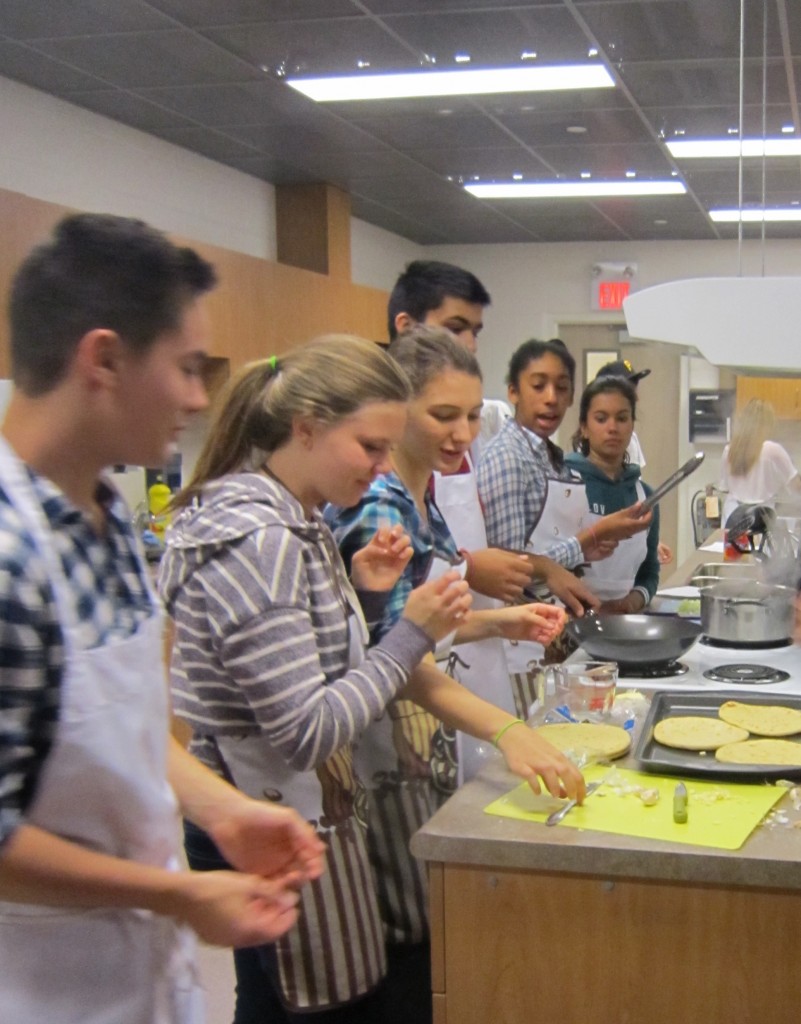 Classes like this won’t take place as long as the pandemic is with us.
2. Minimum Requirements for Synchronous Learning
During periods of remote learning where students are at home for more than three days in a given week, boards must ensure that students are provided with synchronous learning. The minimum requirements for synchronous learning help to ensure that students have access to both synchronous and asynchronous learning opportunities.
The scheduled synchronous learning sessions must be communicated to parents and students. Educators should use their professional judgement to provide some flexibility to students on an individual basis when students are unable to participate in synchronous learning.
The table below outlines the minimum amount of time per day that students, depending on their grade level, must be provided with synchronous learning as part of their scheduled or timetabled learning.
Division Grade Level of Students Daily Minimum Synchronous Learning Time Requirement*
Elementary Kindergarten 180 minutes
Grades 1 to 3 225 minutes
Grades 4 to 8 225 minutes
Secondary Grades 9 to 12 The higher of 60 minutes for each 75-minute class period** or 225 minutes per day for a full course schedule
* This is in addition to asynchronous learning time.
** The synchronous learning time requirement for any period that is not 75 minutes should be adjusted to reflect this ratio.
The synchronous learning time requirements outlined in the table above may be divided into shorter periods throughout the school day. For example, a child in Kindergarten may participate in an opening exercise for 10 minutes with their whole class, as well as a combination of whole-group and small-group sessions throughout the school day, and a 10-minute closing exercise with their class at the end of the school day.
It is expected that synchronous learning will be provided for large and small groups of students each day, in a manner similar to in-person classroom teaching. Synchronous learning time may include students working independently and in small groups while engaged in a virtual classroom with the teacher overseeing their learning and available for questions. The synchronous learning requirements are a part of the 300-minute instructional day during which teachers remain available to students as per the previous section “Minimum Requirements for Engaging Students during Remote Learning.”
Additional group meetings may take place between educators and students as needed to address specific learning needs. Where students are able to attend in-person classes and also participate in remote learning, school boards should plan, where possible, to assign different educators to facilitate both formats of instruction. This will ensure that students are engaged in their learning with appropriate levels of support.
3. Process for Exemption from Synchronous Learning
School boards must allow for students to be exempted from the minimum requirements for synchronous learning stated above, on an individual basis.
School boards must develop a process to obtain and acknowledge the receipt of exemption forms. Requests for an exemption must be made in writing. Exemption from synchronous learning may be requested by parents or by students who are 18 years of age or older, and students who are 16 or 17 years of age but have withdrawn from parental control.
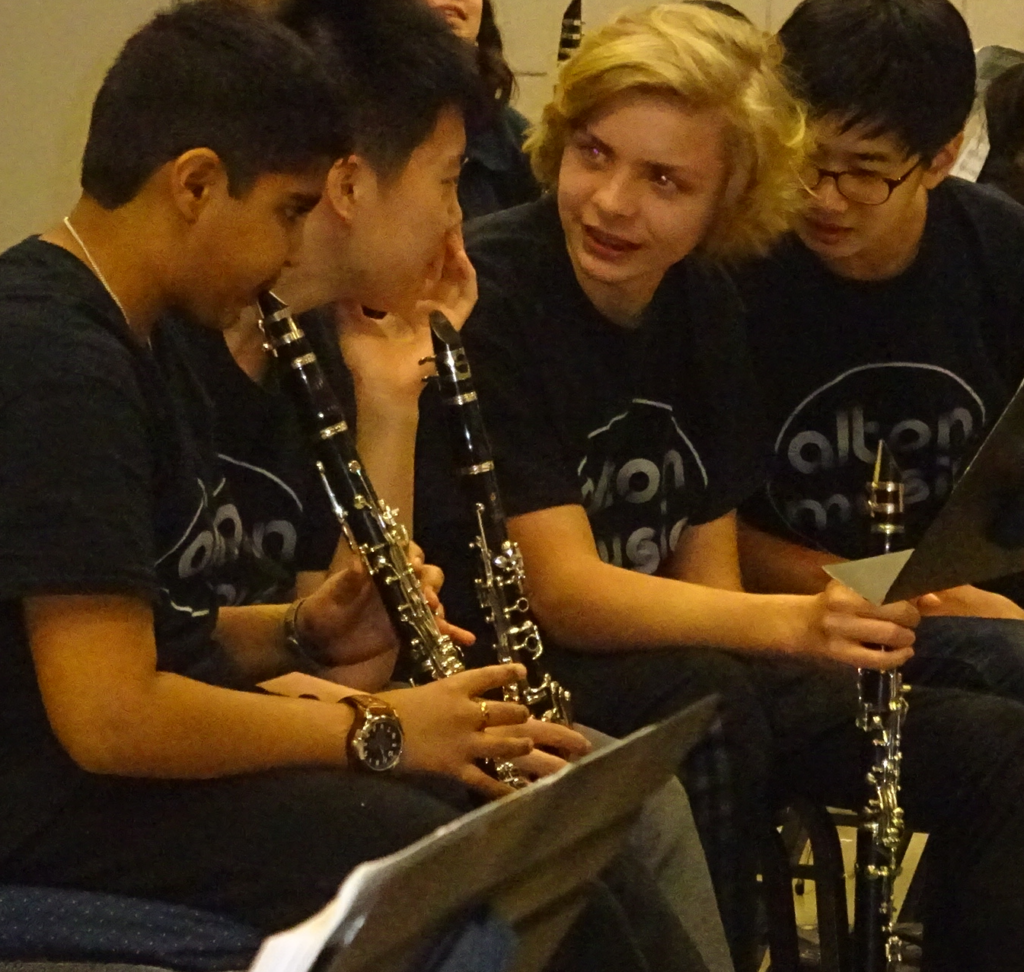 Social for sure – but no distancing. School is not going to be the same. To support meaningful access to education, alternative learning approaches must be put in place for all exempted students – for example, correspondence, print, or broadcast media instruction that is based on the individual student’s needs and circumstances. Additional supports for parents should also be considered. Exempted students must be provided with a daily schedule or timetable in accordance with the 300-minute instructional day.
4. Protocols for Delivering Remote Learning
School boards must ensure that the delivery of remote learning includes the following elements:
Communication Processes
School boards must inform students and parents about remote learning requirements, including the process for exemption from synchronous learning, and expectations for student attendance and engagement.
School boards should clearly communicate a process whereby parents can inform the school of any issues that their child may be experiencing with remote learning, and provide steps that parents may take to resolve any issues.
Teachers should communicate with the principal, students, and parents a regular schedule of synchronous learning sessions that fulfills the minimum time requirements, as part of their remote learning timetable. Teachers should accommodate parents who request a meeting through other modes (e.g., by telephone, through a virtual platform) when an in-person meeting is not possible.
Differentiated Assessment and Instruction
Teachers should provide daily opportunities for each student to receive meaningful feedback.
The policy outlined in Growing Success: Assessment, Evaluation, and Reporting in Ontario Schools, 2010 continues to apply during periods of remote learning and teachers should employ assessment for, as, and of learning (including diagnostic, formative, and summative assessment), as required.
Teachers should provide differentiated support to all students, including English and French Language Learners, and students with special education needs who have an Individual Education Plan (IEP).
Supporting Students with Special Education Needs
Where appropriate, educators should provide more opportunities than the minimum requirements for synchronous learning for students with special education needs, based on their individual strengths and needs, and provide differentiated support and instruction.
Educators should continue to provide accommodations, modified expectations, and alternative programming to students with special education needs, as detailed in their IEPs. If it is not possible to meet a student’s needs through synchronous learning, educators and families will work together to find solutions.
School boards are encouraged to provide continued access to assistive technology, including Special Equipment Amount (SEA) equipment, where possible, to support students with special education needs as they participate in remote learning. In situations where access to assistive technology is not feasible, educators are expected to work with students and parents to determine workable solutions on an individual basis.
Student Attendance and Safety
Student attendance must be taken daily at the elementary level and per course at the secondary level. Principals must ensure that student attendance records are submitted and that a staff member is assigned to contact parents in the case of an unexpected absence, in accordance with school and board attendance protocols.
In cases where a student is unable to participate in a synchronous learning session – for example, their device may be shared with a parent in the home – teachers should be informed, and they should make curriculum and assessment accommodations on an individual basis.
Boards may review how attendance counsellors could be used to further support student attendance, engagement, and well-being.
Boards must ensure that teachers follow school board-established procedures related to online safety, privacy, and cyber security.
5. Access to Remote Learning Devices – such as Laptops or Tablets – and the Internet
School boards must work collaboratively with parents to ensure that all students have access to remote learning devices and the Internet during remote learning. School boards are expected to provide remote learning devices and Internet connectivity to students who do not otherwise have access to them, and to develop policies on how these resources will be allocated on an equitable basis.
In situations where students do not have access to remote learning devices or the Internet, and a school board is unable to provide this support, school boards should have a process in place to work collaboratively with students and parents to establish alternative arrangements on an individual basis.
School boards should also consider how to support students in Education and Community Partnership Programs (ECPPs), including students in youth justice ECPPs, where access to the Internet may not be available or may be restricted due to a court order.
Teachers should work from a school or board facility during remote learning, where possible, with reasonable accommodations if required. If this is not possible, teachers should maintain regular communication with the principal. School boards should support educators in accessing remote learning devices and tools to support remote and synchronous instruction.
6. Standardized Suite of Synchronous Learning Platforms
School boards must provide teachers with a standardized suite of synchronous learning platforms to ensure that students have a consistent learning experience, and provide teachers with training on these platforms. The platforms will allow real-time communication between educators, students, and parents during remote learning.
Synchronous learning platforms should include live video, audio, and chat features and be fully accessible. To support student safety and well-being, school boards should consider providing a tool that allows educators to control student microphones and cameras. School boards may also wish to consider synchronous learning platforms that include virtual whiteboards, recording features, participant polling features, and file uploading and sharing features.
7. Cyber Security, Privacy, and Online Safety
Ensuring the protection of privacy and the cyber security of educators, students, and parents is paramount to supporting a safe and inclusive learning environment for remote learning.
School boards must review their cyber security and privacy policies, and develop updates related to remote learning. These policies must include clear protocols and procedures for educators to follow so that they can ensure student safety and security during remote learning. These protocols must be clearly communicated to educators, students, and parents.
Board protocols should ensure that students and educators do not share passwords, that student initials are used for account creation instead of full names, that teachers are the last ones to leave synchronous learning sessions, and that students and teachers are aware of and respect board policies regarding digital conduct and privacy.
School boards should provide professional resources to all school staff to increase cyber security awareness.
Effective Practices
To support students and educators during periods of remote learning, school boards should develop effective practices, including:
providing technical support for remote learning
providing educator training
using standardized platforms
setting out roles and responsibilities
1. Providing Technical Support for Remote Learning
School boards should provide technical support to educators, students, and parents for the use of board-provided devices and access to the Internet during remote learning.
Technical support should be responsive to immediate needs. It should assist users who have specific technological problems and questions. In the context of remote learning, technical support should span the full spectrum of users’ technological needs, including devices, connectivity, security, and digital learning tools and applications.
Board staff, educators, students, and parents should know where to seek help when they encounter technical issues during remote learning. School boards should provide clear information on who can provide help (e.g., board staff, service providers), and how users can access that help (e.g., by email, telephone).
2. Providing Educator Training
Educators should have access to subject- and division-specific training to support remote learning.
School boards should deliver remote learning strategies and educator training related to:
student and staff safety;
student and parent comfort levels with technology, and the levels of support that may be required;
effective use of digital tools;
effective pedagogy and assessment;
student and staff mental health and well-being;
accessibility and differentiated instruction for all students, including students with special education needs.
3. Using Standardized Platforms
Educators should use board-approved synchronous learning platforms that are fully accessible.
Principals should ensure that educators have access to a suite of appropriate technology products, tools, and resources to support the delivery of remote learning. To ensure that students have a consistent learning experience, the maximum number of synchronous learning platforms used within a school should be three, where possible.
4. Setting Out Roles and Responsibilities
School boards should consider the rights and responsibilities of students, parents, teachers, educational assistants, early childhood educators, and other school and board staff during remote learning.
Teachers are expected to carry out the instructional duties assigned to them by their principals and to comply with all professional standards and obligations under the Education Act and the Ontario College of Teachers Act, 1996. These include having responsibility for the effective instruction and evaluation of the progress of students in the subjects and classes assigned by the principal (including by electronic means), preparing and submitting lesson plans to the principal, and communicating regularly with parents.
Technology Enabled Learning and Teaching (TELT) contacts at each school board can play an active role in supporting communication of the policy, educator training, and implementation of remote and synchronous learning. For example, they can support the use of the ministry’s Virtual Learning Environment, which provides educators with training related to digital learning tools.
Implementation
School boards must ensure that the requirements outlined in this memorandum are implemented by the beginning of the 2020-21 school year.
School boards are encouraged to consider local needs and circumstances, and to consult with local partners in their implementation of remote learning. In the French-language education system, the implementation of remote and synchronous learning should take into account Ontario’s aménagement linguistique policy and support the vitality of the French-language culture in a minority setting.
Monitoring and Evaluation
School boards are required to report at the end of the school year on their activities to fulfill the direction outlined in this memorandum.
School boards are expected to develop and implement a process for regular data collection, and to collect data related, but not limited, to:
areas in which educators require additional support in implementing remote learning, including providing student and educator access to technology and the Internet;
strategies to provide training related to the identified areas of need, including learning and well-being;
details of implementation progress and monitoring activities, including the number of exemptions from synchronous learning and what alternative approaches were used;
parent and student feedback on the impact of remote learning, including:
level of student engagement in learning;
ease of online learning participation;
access to teachers;
ease and access to technology;
information on how parent and student feedback is being taken into account in the delivery of remote learning.
Data covering the school year must be provided to the ministry no later than July 31 of each year in which there are periods of remote learning.
School boards are expected to make adjustments to their implementation of the requirements in this memorandum based on parent, student, and staff feedback collected throughout the school year.
Upon request of the ministry, school boards may be required to report on the following data during the school year:
for any given calendar month, the number of students engaged in remote learning;
for any given calendar month, the number of students provided with the minimum requirements for synchronous learning;
for any given calendar month, the number of students exempted from the minimum requirements for synchronous learning.
1 In this memorandum, unless otherwise stated, student(s) includes children in Kindergarten and students in Grades 1 to 12.
2 In this memorandum school board(s) and board(s) refer to district school boards, school authorities, and Provincial and Demonstration Schools (including the schools operated by the Centre Jules-Léger Consortium).
3 In this memorandum, parent(s) refers to parent(s) and guardian(s).

 By Staff By Staff
August 13th, 2020
BURLINGTON, ON
City Council does have to come up with a budget before the end of the year.
The Province of Ontario announced as part of the federal-provincial Safe Restart Agreement that the City of Burlington will receive $4,470,700 to support municipal operating pressures for Phase 1 and Burlington Transit will receive $1,571,213 to support municipal transit systems for Phase 1.
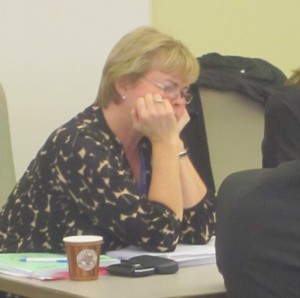 Joan Ford, the city’s Director of Finance doesn’t have to worry as much about where the money to pay the bills is going to come from. Senior City staff will be presenting the monthly COVID-19 verbal update to the Corporate Services, Strategy, Risk and Accountability Committee Meeting on Thursday.
At the last monthly update to Burlington City Council on July 9, the City was estimating revenue losses of $18 million. The City was able to mitigate $9.9 million for a projected year end shortfall of $8.1 million before needing to draw from reserve funds.
If memory serves us correctly the shortfall was in the $4 million range
Municipalities will be provided with up to $1.6 billion as part of the first round of emergency funding under the Safe Restart Agreement.
This funding will help municipalities like Burlington protect the health and well-being of residents, while continuing to deliver critical public services to our community and assist with economic recovery.
Through the Safe Restart Agreement with the federal government, $695 million will help municipalities address operating pressures related to the COVID-19 pandemic through the first round of emergency funding, and over $660 million will support transit systems. The province is also providing an additional $212 million through the Social Services Relief Fund to help vulnerable people find shelter.
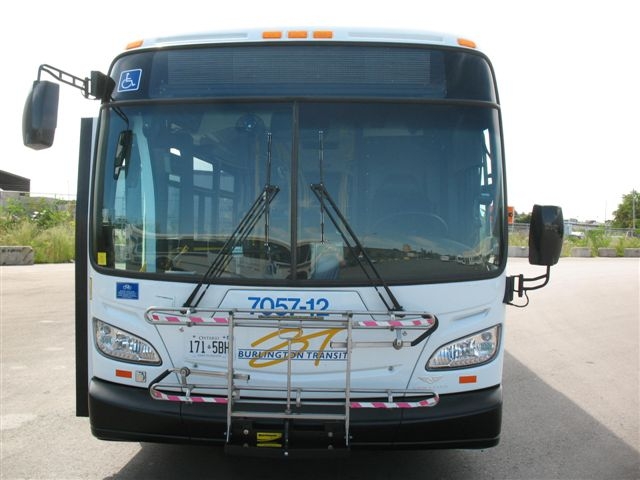 There will be money for the transit service – will there be passengers willing to ride the buses – especially if they are crowded. In addition to the support for municipalities, the government is providing over $660 million in the first phase of transit funding to the 110 municipalities with transit systems. The funding can be used to provide immediate relief from transit pressures, such as lower ridership, as well as for new costs due to COVID-19, such as enhanced cleaning and masks for staff.
In the second phase, additional allocations will be provided based on expenses incurred to ensure the funding meets the needs of municipalities. As part of the Safe Restart Agreement with the federal government, up to $2 billion is being provided to support public transit in Ontario.
Mayor Marianne Meed Ward said: “This is exactly the support we need from our upper levels of government to continue to provide the services our residents need, in the midst of COVID-19. Today’s funding announcement for Burlington will allow us to continue to serve our community without service cuts, unacceptable tax increases or depleting reserves.

 By Staff By Staff
August 12th, 2020
BURLINGTON, ON
The wearing of face coverings/masks is known to pose a significant barrier to the Deaf community, as masks make it harder to lip read and understand sign language.
To better serve the demographics of our community, while continuing to mitigate the transmission of COVID-19, Halton Regional Police Service officers are now equipped with ClearMasks™.
 “Our ability to communicate with the members of our community is absolutely essential,” says Halton Regional Police Service Deputy Chief Roger Wilkie. “With guidance and input from the Bob Rumball Canadian Centre of Excellence for the Deaf, we have now removed a significant communications barrier.” “Our ability to communicate with the members of our community is absolutely essential,” says Halton Regional Police Service Deputy Chief Roger Wilkie. “With guidance and input from the Bob Rumball Canadian Centre of Excellence for the Deaf, we have now removed a significant communications barrier.”
“By introducing ClearMasksTM within Halton Regional Police Service, anyone from the Deaf community can now have more accessible dialogue with police officers,” says Jayne Leang, Director of Business Relations at the Bob Rumball Canadian Centre of Excellence for the Deaf.
“In an emergency situation, allowing a person who is Deaf or hard-of-hearing the opportunity to see the officer’s facial expression or attempt to read their lips, helps in the exchange of potentially life-saving information.”
These Health Canada-approved masks feature a transparent window, allowing the mouth to be fully protected, while fully visible, for those who use speech reading, lip reading or who are profoundly deaf and use American Sign Language, which is heavily dependent on facial expressions

 By Pepper Parr By Pepper Parr
August 11th, 2020
BURLINGTON, ON
It was the end of a long week – with the week ahead not looking all that much better.
 Director of Education Stuart Miller is being pressed on all sides – the situation he faces is far more challenging that the closure of two high schools. Stuart Miller and his team are bushed. They have been given their marching orders by the province; they now have to make it happen with what they have.
Every elementary student will be in their home classroom – teachers will come to them; the students will take recess and lunch together and not mix or mingle with other students. In some grades they will be asked to wear masks.
There are likely to be some classes that will have in excess of 25 students – some report that there will be classes with 30 students – when you add the teacher and the EA that is a pretty full room making it difficult to stick to the six foot apart rule.
It is going to be a challenge to keep the different classes apart come recess and lunch – a scheduling nightmare.
The secondary students will do a day in a classroom – just 15 in the class, the following day they will work from hone on-line where they will be taught synchronously by their teacher.
Parents who are concerned about the safety of their children, teachers who are apprehensive and an HR department that needs to make sure they have access to supply teachers who may have to replace classroom teachers who decide they do not want to be in classrooms.
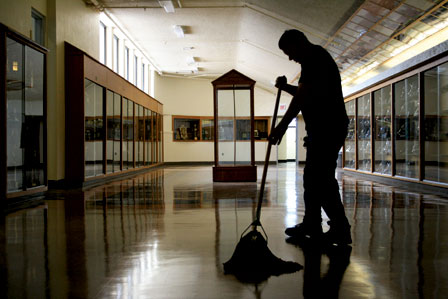 The clean ups at every school will be very through and very frequent. Custodial people have to be hired as well.
The teachers were sent a 79 page document setting out the way the school board administration expects things to work in a situation that is both dynamic and fluid.
Parents will be getting a document with much of the same information on Monday and are asked to let the Board of Education know what they plan to do with their children.
“Some parents won’t get back to us” said Miller. “We will have principals at the schools calling those parents to find out what they want to do.
“We also have number of households who have more than one student going to high school. That will mean each student having access to a laptop computer which for some families may not be in their budget.
The Board will ensure that everyone has what they need to be able to take part on those half days when high school students are being taught synchronously as a class on-line.
There will also be some students who will attend a class within the school due to limitations they have with on-line learning.
The teachers doing the online teaching will do so from the schools – perhaps not from the actual classroom but their base will be the school.
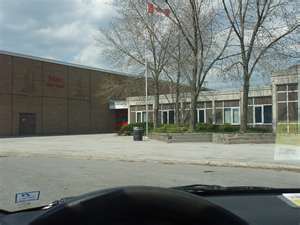 The upgrade at Nelson high school meant to accommodate the students transferring out of Bateman has been delayed – keeping students in their old school. Delays at Nelson high school where additions are underway to accommodate the transfer of students from Bateman high school to Nelson – with Bateman to be closed at some future date – will be delayed due to construction issues that resulted from the shutdown of the site when a worker was tested positive.
The province has budgeted for some 500 nurses who will be available to schools. With 105 schools in the Region and 44 School Districts in the province those nurses are going to be stretched pretty thin.
Exactly what the nurses are going to do is not clear. What is clear to Miller is that he has an excellent working relationship with the Medical Officer of Health, (MOH) Dr Hamid Megani. All the bases will be covered.
The overriding concern is having a procedure in place for those schools where a hot spot turns up. The Board wants to be able to move quickly and isolate any outbreak and ensure that if there is one it is limited to a classroom and not school.
Everyone is working full out on ensuring that they get it right the first time.
Miller, who has been an educator for more than 35 years, said that what he is going through now “is not something they taught us in principal school.”
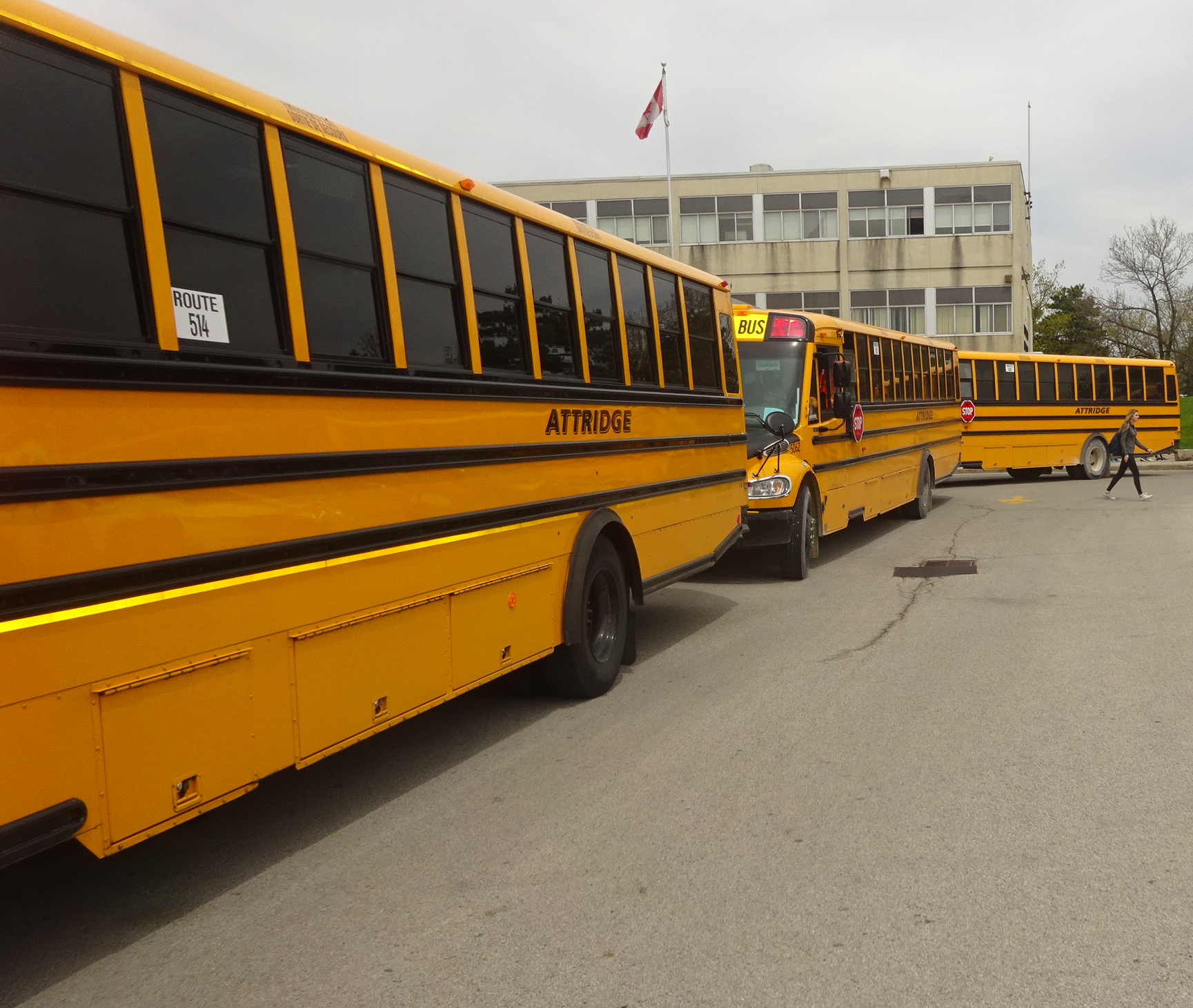 How many students in each bus – are there enough buses? Getting the students to school is another challenge that is being worked on. How many children will be permitted on each bus – will there be enough bus drivers. And how will the bus routes and schedules be worked out. The service is operated by an arm’s length operation that serves both the Separate and Public Boards.
In the past few weeks the number of new infections in the Region have been low – 0 in some days and the MOH has been able to move very quickly tracing who the infected person has met with. That same dexterity will be used to track the students.
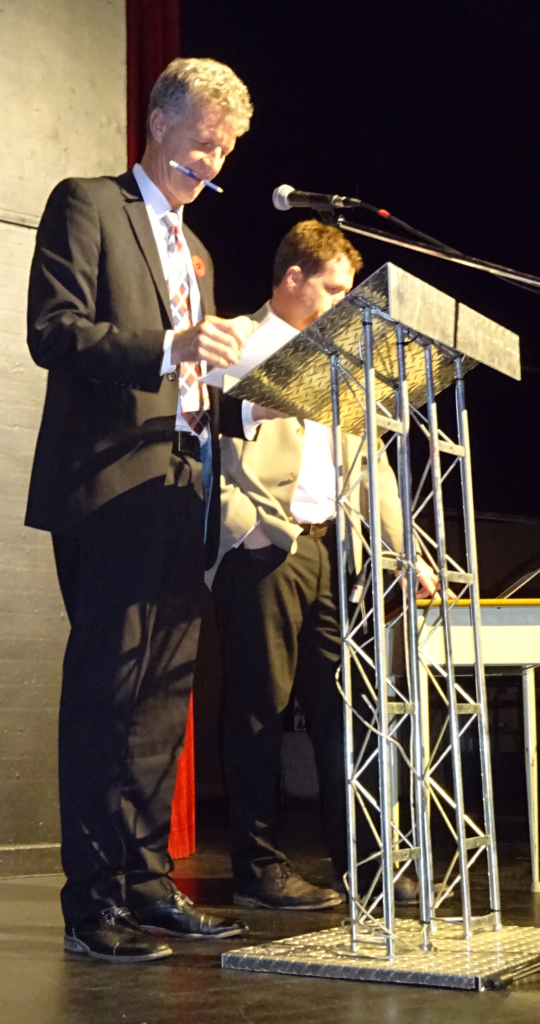 Director of Education Stuart Miller facing the biggest challenge of his career – making sure the students he is responsible for educating are safe. There are dozens of pinch points – the school board administrators believe they have identified all of them but the words “fluid” and “dynamic” are used to describe everything they have to deal with.
There are a lot of “not sure” statements being made. A lot of trepidation on the part of parents, teachers and board administrators.
The public isn’t hearing a word from the trustees.
If the infections in each municipality can be kept low that should be reflected in the school environment.
What happens when parents who have worked from home begin returning to their offices and the colder weather becomes part of everyday life?
We are going to have to cross that bridge when we come to it.

 By Staff By Staff
August 9th, 2020
BURLINGTON, ON
A Halton resident has tested positive for West Nile Virus (WNV).
This is the first human case for Halton this year.
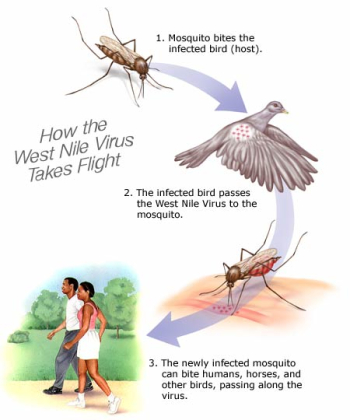 This is how the West Nile virus is transmitted.. “Halton Region Public Health works diligently to reduce the risk of West Nile virus in our community through both education and preventative programs such as larviciding.
Until the fall frost, Halton residents should continue to protect themselves against mosquito bites and remove mosquito breeding sites,” said Dr. Hamidah Meghani, Halton Region Medical Officer of Health.
“While 80 per cent of people infected with West Nile virus will have no symptoms, others will have West Nile fever consisting of fever, headache, muscle ache and a rash. These symptoms are very similar to illnesses such as COVID-19, so it is important for residents who are concerned or experiencing symptoms, to seek medical assessment.”
Residents are encouraged to take the following steps to protect themselves and their families from mosquitoes:
• Urban areas are more likely to have mosquitoes that carry WNV. Reduce mosquito breeding sites around your home at least once a week by getting rid of water in containers and objects such as wheelbarrows, tires, plant pots, old toys, plastic pails and wading pools.
• Avoid areas where mosquitoes are known to be present such as wooded areas, golf courses or gardens, especially at dawn and dusk when mosquitoes are most active.
• If you are going to areas where mosquitoes are active, cover up by wearing light-coloured, long-sleeved shirts and pants with tightly woven fabric.
• Use a mosquito repellent (bug spray) containing DEET or Icaridin.
• Make sure your window and door screens are tight and without holes, cuts or other openings.
• Change the water in bird baths at least once per week.
If residents see standing water on public property for longer than a week, they can report it to Halton Region by emailing accesshalton@halton.ca or calling 311.
As part of its ongoing West Nile virus surveillance and larviciding program, Halton Region Public Health staff continue to monitor areas of standing water, eliminate potential mosquito breeding sites and apply larvicide when mosquito larvae is found during Regional monitoring and surveillance.

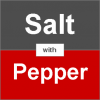 By Pepper Parr By Pepper Parr
August 6th, 2020
BURLINGTON, ON
Hospitals – vital and expensive.
Burlington has had an, at times, awkward relationship to the Joseph Brant Hospital.
It took a long time to get the provincial funding for the upgrade of the older parts of the building and the construction of the new wing.
Former Mayor Rick Goldring got a bit of a shock when he was told by the province that the city was going to have to come up with a large part of the construction cost.
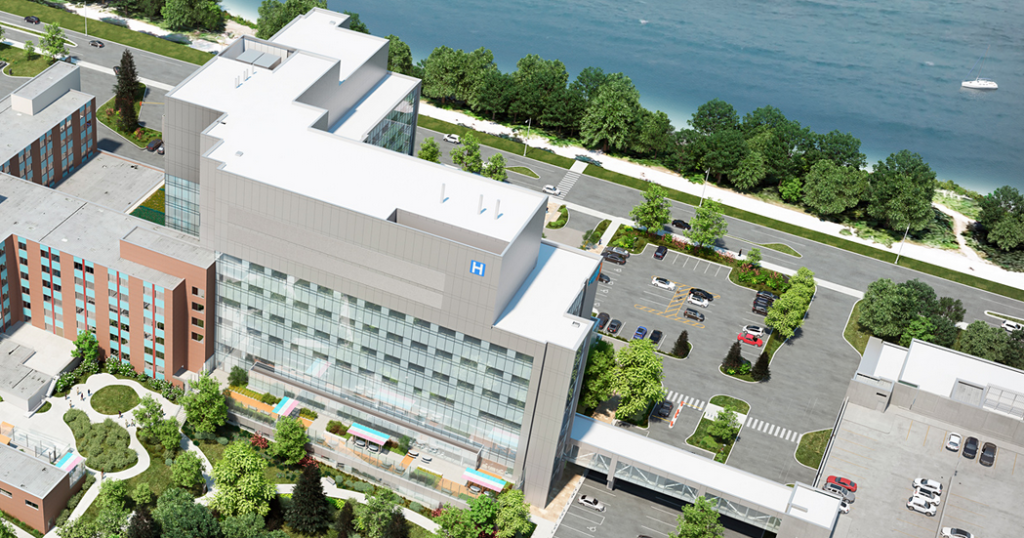 A special tax levy was required to pay for the city’s portion of the hospital – which taxpayers willingly paid. The amount was so big that the city had to impose a special tax levy to raise the funds – and the public willingly paid that additional tax levy.
The city then found a way to roll that tax levy over into a source of funds for other needed service. The public wasn’t as happy with that little tax trick.
One would have thought the city council at the time would have at least asked – truth be told they really didn’t even come out and tell the taxpayers what they were doing – they just did it.
The Gazette was also the news source that dug out many of the facts relating to the c-dificile tragedy at the hospital that resulted in the deaths of at least 80 people.
Yesterday we published a piece on the experience of two people at different area hospitals: The Joseph Brant, where a woman had an appointment and how she was treated. Then in the same piece, about a male who had an appointment at the St. Joseph’s Hospital in Hamilton.
Two very different experiences.
We expect a strong reaction to that article and be accused of picking on the Joseph Brant Hospital. What we were doing was pointing out the different cultural base from which each hospital works.
St. Joseph’s was formed by the Sisters of St. Joseph: nuns who brought a different touch to patient needs.
Burlington’s Joseph Brant doesn’t have that deep historical cultural commitment that is needed. That culture can be grown – the leadership at the hospital has to show by example how patient care can be done differently.
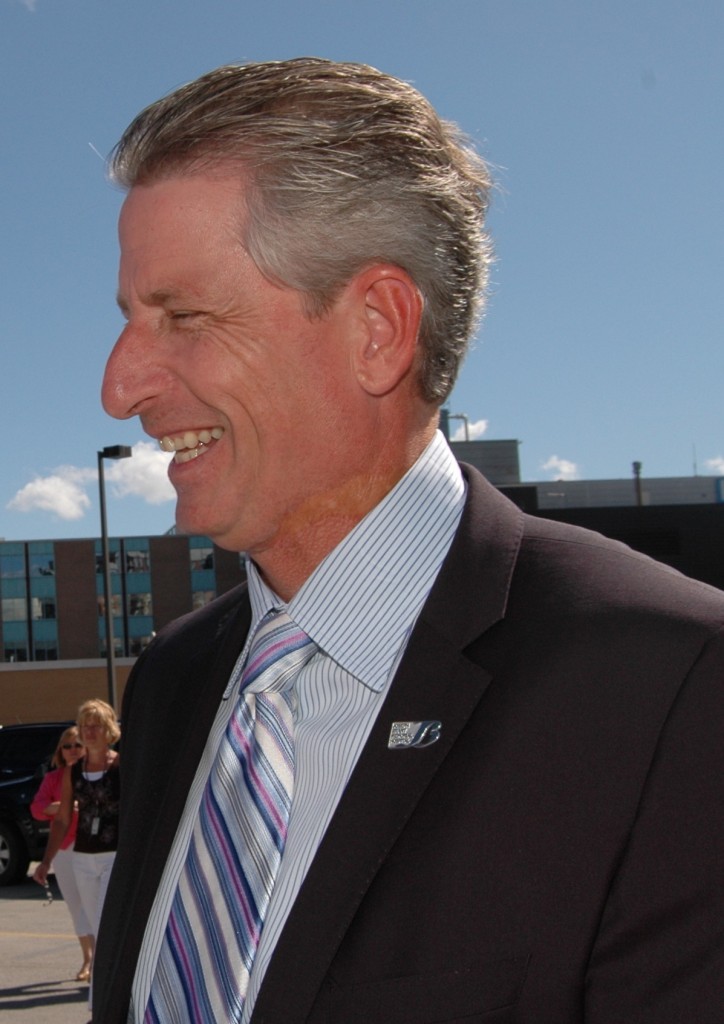 Joseph Brant Memorial Hospital CEO Eric Vandewall. The Joseph Brant has done some very fine medicine. Eric Vandewall ensured that the renovation and new build was done close to perfect.
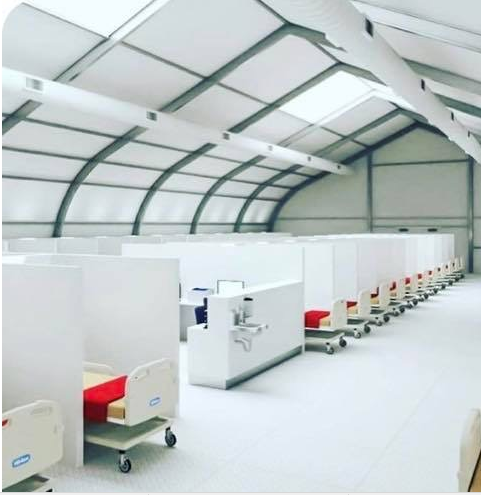 It was a high end field hospital that went up very quickly – hasn’t been used – yet. He made the brave decision to spend $2 million on a facility that could be used for any over flow of COVID-19 patients.
The space has not had to be used – yet.
Some will suggest that was $2 million wasted. It wasn’t wasted. Vandewall did what he believed was a prudent decision and we don’t think he was wrong.
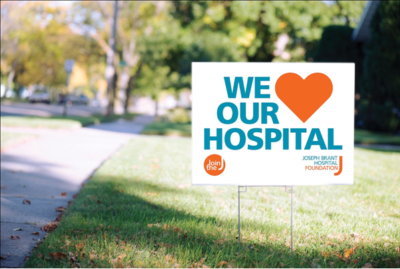 Telling us how they feel about their hospital. Burlington has thousands of people who willingly put up a sign on their lawn declaring how much they love their hospital. Nothing wrong with solid civic pride.
What we would like to see is the evolution of a different culture that has people experiencing the care and concern that one person experienced at St. Joseph’s in Hamilton and not the experience a woman had at Joseph Brant.
It can be done but it won’t be done until someone at a very senior level makes the change a personal mission.
Related news stories:
The cute tax trick with the hospital tax levy.
Two different patient experiences

 By Staff By Staff
August 5th, 2020
BURLINGTON, ON
Two people about a decade apart in age – both were on the other side of the 60 line, had very different experiences at area hospitals
Both had experienced significant medical procedures.
One, the female, was a patient at the Joseph Brant Hospital in Burlington.
The other, male, was a patient at the St. Hospital in Hamilton.
Both had gone to their hospitals a day apart this week.
We are not releasing the names – that isn’t the important part of this story. It is about how people are treated and the integrity of the service being given at the two hospitals.
 The Joseph Brant Hospital, recently underwent a major overhaul with the addition of a new wing that is clean, and a pleasant place to be if you have to be in a hospital. What needs work now is a change in the culture where the patient is the focus. The female scheduled an appointment at Joseph Brant Hospital.
She was wearing a mask when she entered the front door.
She was met by a young man who asked the following questions.
– did I have an appointment or was I visiting a patient?
– He asked for my name and if I had travelled out of the country.
– He asked if I had fallen in the last 3 months.
He gave her the form he had completed and told her to give it to the nurse at the appointment.
She then went on her own to the elevators and up to her appointment.
She was not asked for the completed sheet. She asked the nurse at her appointment if she wanted the sheet and her answer was “oh yes”.
After my appointment I left the hospital
The male at St. Joseph’s in Hamilton was quite different.
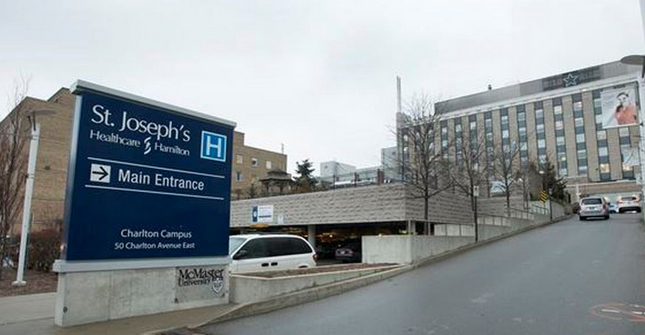 The complex of buildings that makes up St. Joseph’s in Hamilton is big, very big – easy to get confused. Patient service though was very good. He was stopped as he entered the hospital by a young lady holding a clip board.
“Where do you want to go”, she asked.
The male said he was going to the urology unit for an appointment.
He was asked if he had travelled outside the province; asked if he had been in contact with people who were later advised that they had been infected in the last 14 days.
He was asked if he had a high temperature in the past three days.
He was asked if the face mask he was wearing had been washed before he put it on that morning.
The male said it was not clean that morning – but it was clean the afternoon of the day before.
The attendant said take the mask off and wear this and handed the male a new mask.
The male was asked for a telephone number he where he could be reached and then asked if he was comfortable giving the attendant an email address.
With that done the attendant put a green sticker on the shoulder of the shirt he was wearing and was told not take it off and to follow the attendant to the floor of the hospital the appointment was on.
He was told to pay attention to the path that was taken and, when leaving, to take that same path and leave by the hospital entrance he had used coming in.
When the male completed the appointment he returned to the main floor where the attendant approached him, took the green sticker off his shoulder and suggested he sanitize his hands and bid him a “good day” but not before advising the male that he should put on a washed mask in the morning of each day and to replace it with a clean one in the afternoon – and to wash his hands frequently.
Was one hospital “better” than the other? That’s not the issue – how people are treated is a reflection of the culture of the institution.
Cultural change comes from the leadership. There is some work to be done.
Related editorial content
What the Joseph Brant hospital does very well

 By Staff By Staff
August 5th, 2020
BURLINGTON, ON
It is good news – even if it is going to take some coin out of your pocket.
Starting September 1, Burlington Transit will be collecting fares on all Burlington Transit buses. Pay your fares using a PRESTO card.
If you are a SPLIT customer, you can pick up your SPLIT pass starting August 19, at the Downtown Terminal, 430 John St. One customer will be allowed in the building at a time. You may want to add extra time for COVID-19 measures.
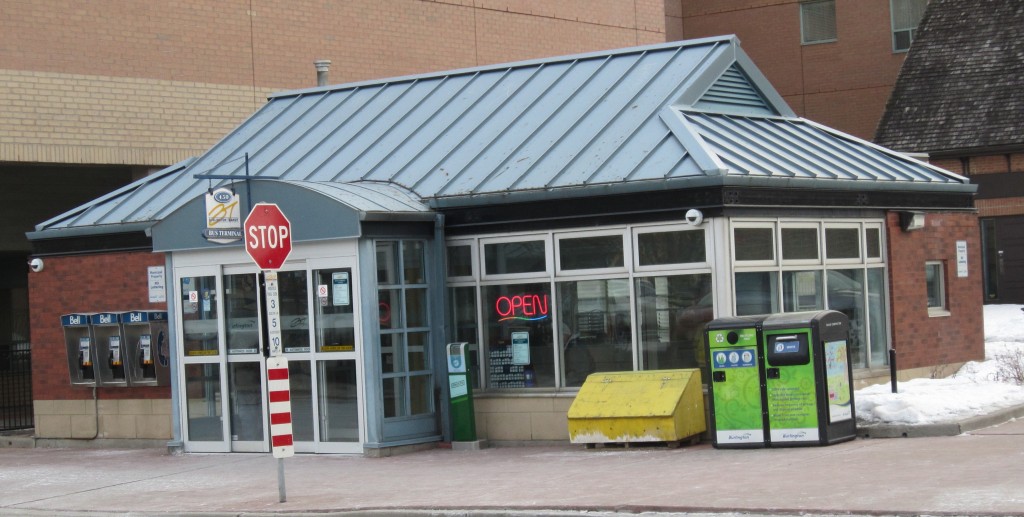 Re-opens on August 19th, limited service – need a mask on to get in the door – one person at a time. Downtown Terminal Re-Opens August 19, 2020
Burlington Transit’s Downtown Terminal, 430 John St., is reopening on Aug. 19, 2020 with limited services. The Terminal will be open Monday to Friday from 9 a.m. to 4 p.m.
We are following provincial and City COVID-19 safety procedures. Please work with us to keep everyone safe and:
• Wear a mask,
• Use hand sanitizer often and
• Give us your name and phone number for contact tracing
We are offering:
• SPLIT Passes
• ePurse Loads
• Free Seniors Pass
• Lost & Found
Right now, we are not selling:
 A revised service schedule has been released. • Monthly Passes
• U-Pass Add-ons
Payment Options
• Debit and Credit Only
ePurse Loads also available at prestocard.ca and GO Stations.
Schedule Changes – Aug. 23, 2020
We are adding more service on all Burlington Transit routes starting Aug. 23.
Peak service is between 5:30 a.m. to 9 a.m. and 3 p.m. to 7 p.m.
Updated Schedules.
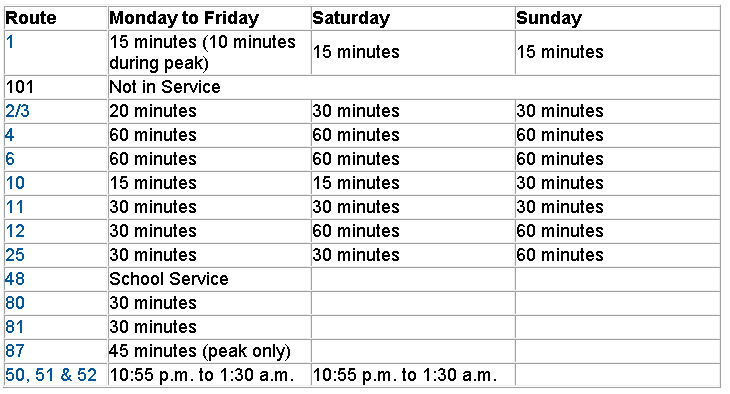

 By Michele Bogle By Michele Bogle
August 5th, 2020
BURLINGTON, ON
The ‘in-tent’ of this article is to shed light on a new cost of doing business in Burlington.
Stage 3 has provided restaurateurs the ability to bring patrons inside but several of the owners I talked to said they didn’t feel the public was ready for that step.
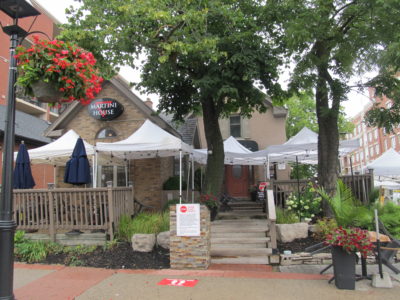 The Martini House had a limited amount of space and managed to make it work. Candlelight at night didn’t hurt. You may have noticed an increasing number of tents popping up around the city for the past month; I toured the tents at Jake’s Grill & Oyster House, Stacked, The Martini House, The Poacher and Jack Astor’s.
The question for the owners of these restaurants isn’t, “How can they not, but rather, can owners actually afford to?”
For those with space, some restaurants have included a tent to an expanded patio setup. For others like The Martini House, space is at a premium so they got creative with the size and number of tents.
Some have spent hundreds of dollars adorning the tents in an effort to mirror that same ‘dining-in’ experience.
Customers are enjoying the tents for larger groups: “We feel like we’re all together this way than at separate patio tables.” Another mentioned that, “With the lights on under the tent, it’s more romantic.”
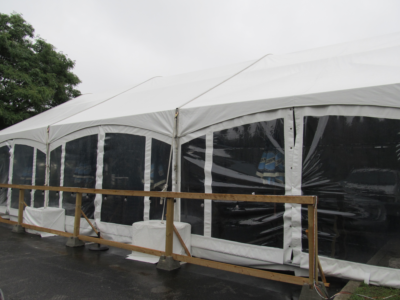 Jake’s Grill & Oyster House went for the high end tent. While the Alcohol and Gaming Commission of Ontario waived fees for licensing under the tents until January 1, 2021 as long as they are COVID-19 safety compliant, the average sized 15’ x 30’ tent rentals start at $500 per day.
Some, who don’t require special customizations, have bought and others have borrowed.
Most owners still offer curbside service and delivery with apps like SkipTheDishes, Uber Eats and DoorDash, but the apps charge, on average, thirty percent per order.
In an attempt to give relief to restaurants during the onset of COVID-19, Uber Eats and DoorDash waived the delivery fee, but only until May. Now the popular apps run assorted promotions like DoorDash who ‘waived delivery fee’ on the first order over $15.
The Poacher’s owner, who has a huge space that will seat 70, admits that the use of the tents makes business barely sustainable in the short term. For obvious reasons, rainy weather like we’ve had for consecutive days now, has a significant impact on business. Owners are looking to October as the magic month of cooler weather that will bring customers back inside the premises.
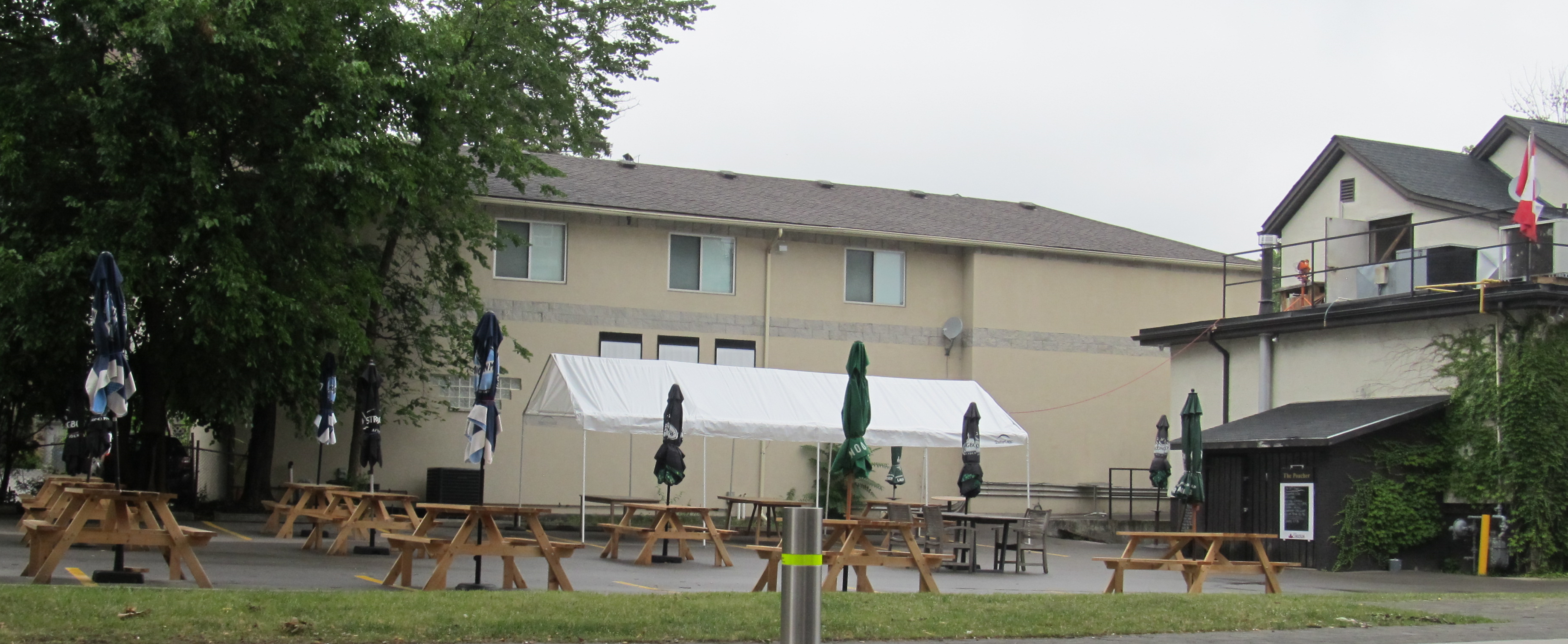 For those who have the space – a reasonably large outdoor operation can be set up. The Poacher has space for 70 people. As a sign of loyalty to the customers many of the restaurants haven’t raised their prices.
In an effort to keep the lights on inside of your favourite eateries, will you consider ‘dining-out’? This sector needs the help and being able to get out for a meal with friends is something that will cheer you up as well.
Michele Bogle is a Burlington based free lance writer with a focus on the hospitality and entertainment sectors.

 By Pepper Parr By Pepper Parr
August 4th, 2020
BURLINGTON, ON
We did a photo feature earlier today with photographs showing people out and about the city not wearing masks.
A number of people thought we were wrong and told us so via their Facebook comments.
The public health objective is to reduce the rate at which infections get passed from person to person.
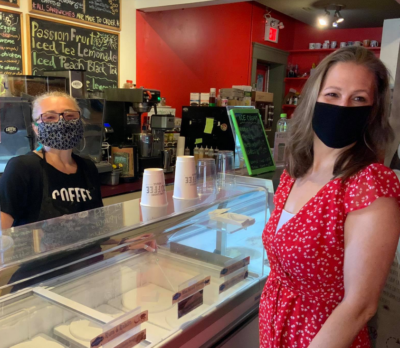 Mayor of the city wears a mask Wearing a face mask was made mandatory by the city in July. The bylaw was very specific – requiring people in offices and retail locations to wear a face mask.
Many think that the wearing of a mask outdoors is not necessary. Is it just a matter of personal choice or does it mean looking at the options and deciding how careful you want to be ?
The risk is certainly lower outdoors – but it is still a risk – when you add the results of geometric progression to that risk you can see why masks work.
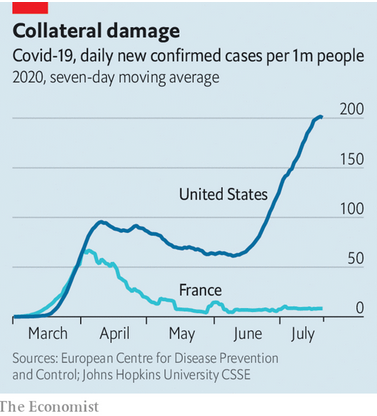 Haven’t heard of geometric progression? The explanation for the pattern of American infections lies in something of central importance to the spread of a virus: geometric progression, such as 1, 2, 4, 8, 16. Haven’t heard of geometric progression? The explanation for the pattern of American infections lies in something of central importance to the spread of a virus: geometric progression, such as 1, 2, 4, 8, 16.
If one person infects two, two infect four and so on. Unless the rate of infection is driven down by reducing contacts, any geometric increase quickly balloons: 256, 512, 1,024.
The graph makes it clear that when lock downs were in place rates of infection dropped. When the Americans opened things up, in early June – and didn’t require masks – the rate of infections soared.
Simple math… 2048, 4096, 8192, 16,384 – do you want to keep going?

 By Pepper Parr By Pepper Parr
August 4th, 2020
BURLINGTON, ON
It wasn’t the greatest long weekend was it?
The Saturday sunshine worked for a lot of people – some of the rules didn’t work all that well.
The city passed a temporary bylaw requiring requiring people to wear face masks.
Our roving photographer wandered around the city looking in on the traditional hot spots – the Beach, the Pier and the downtown area. It was hard to find anyone wearing a mask.
Do people not know – or they just don’t give a damn.
A picture being 1000 words – here is a long story.
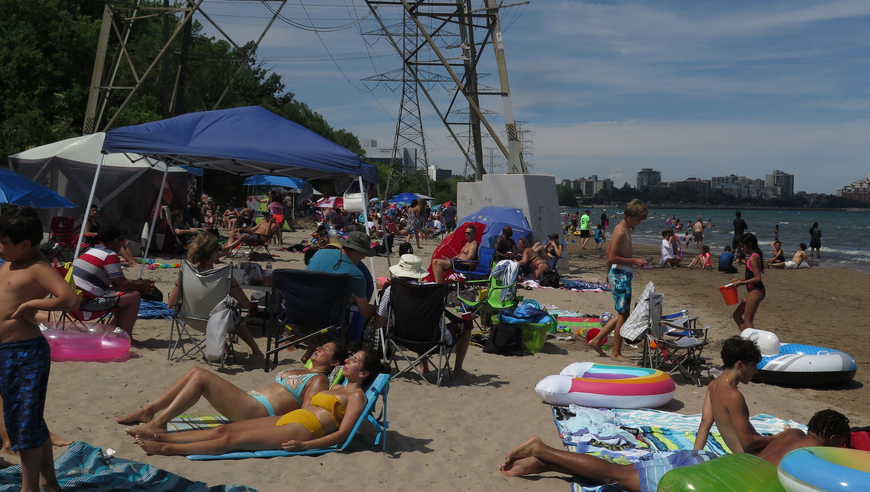 The Beach was packed – no masks but it didn’t seem to matter and it would get in the way of acquiring that tan. 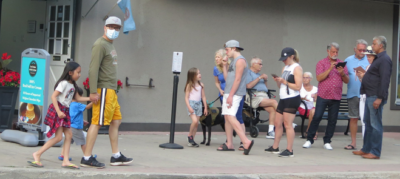 People outside a local shop. Not many masks being worn here. Beer Store on the right – line up respecting the six foot thing – but no masks. 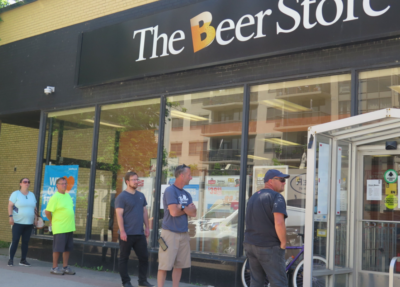
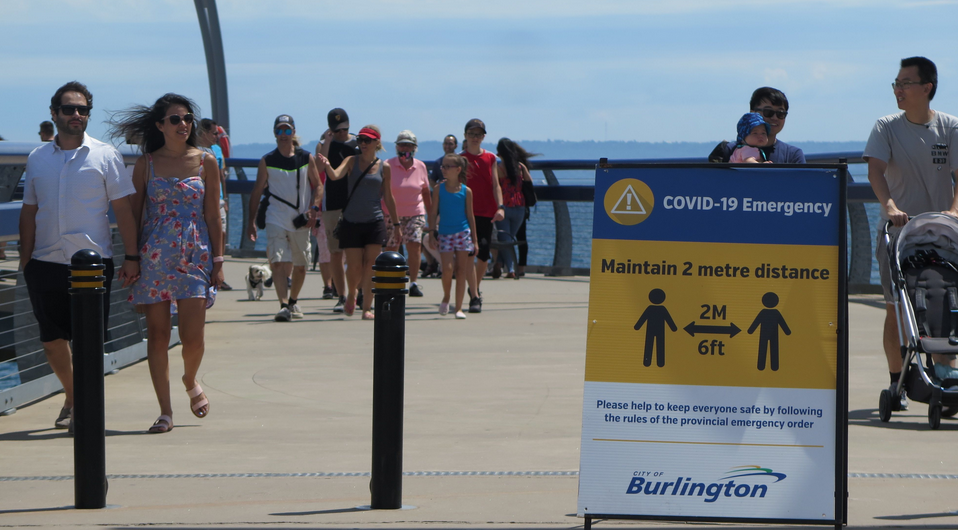 Maybe the summer breeze made it unnecessary to wear a face mask 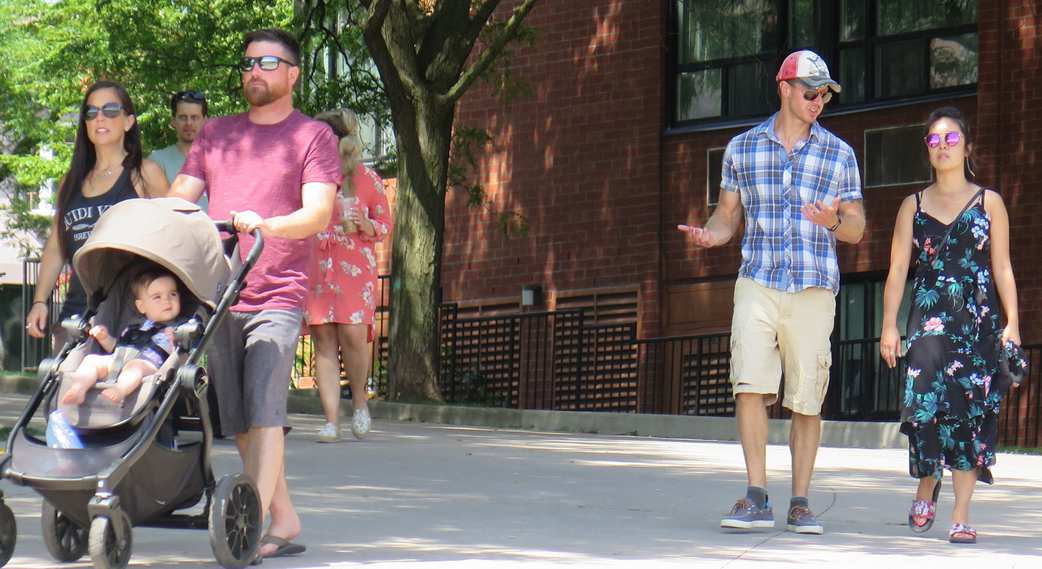 On the way into Spender Smith Park. Great weather – no masks. 
 By Pepper Parr By Pepper Parr
August 4th, 2020
BURLINGTON, ON
We’ve all worked and sacrificed a lot to get us to this new normal.
Businesses are opening up across the Region and life is resuming some sense of normality, including riders coming back to public transit.
There is a dotted line that connects life when we are not using public transit to keeping others safe when you do use public transit.
 Metrolinx senior manager of media, Anne Marie Aikins Metrolinx senior manager of media, Anne Marie Aikins – who has been acting as the Emergency Information Officer for Metrolinx during the COVID-19 pandemic – connects those dotted lines.
“ At this point in time it is so easy to let our guard down.
“To give in – for a bit – and try not to let the ongoing pandemic rob of us of any more intimate moments of close contact with those we’ve done without.
“But this war on COVID-19 is not over – not by a long shot. It is easy to forget the enemy and leave a door open.
“Our actions in the back yard, or on a restaurant patio, or greeting friends in a park on a bright summer day, carry over into every other part of our days – and the many people we come in contact with or even pass on a GO Transit train or bus.”
Metrolinx began 2020 by initiating their pandemic response plan. It has been over six months since the first person in Canada tested positive for the Coronavirus. And now more than 116,000 people have tested positive and, tragically, nearly 9,000 have died from this virus.
For more than 130 days, at times excruciatingly lonely days, people have faithfully followed the guidance of our public health officials.
 Masks for everyone – everywhere. “That’s a long time to go without any hugs or handshakes, parties or celebrations, sustained visits or contact with our colleagues, family and friends who nurture, entertain, commiserate and support us throughout our life during the best of times but most especially during the worst of times” said Aikins, who adds: We’ve all been starved of contact and connection.
“We’ve missed all the usual weddings, graduations, vacations and funerals. No video conference call can ever replace the healing power of a single warm embrace.
“No doubt, life has been hard — especially for those on the front lines. Many people have really suffered, lost loved ones to this virus, lost income due to job loss or lost a stable home or relationship. Our collective mental health has taken a beating and many are feeling wounded.
“We’re exhausted by it all and desire some sense of security and peace that only our friends and family can provide.
“I get that. I’m an extrovert that thrives around smart, creative, funny, passionate people – but there is so much to lose if we let our exhaustion give into the desire to throw the health rules under, well, the bus.”
Public health officials have seen some worrisome trends of late — although we’ve continued to make progress on reducing the transmission, the numbers of people contracting the virus still persists and younger people now account for half the growth of cases perhaps related to house parties or other big gatherings.
Convincing our youth to use protection has always been a challenge we’ve often failed at miserably. Risky behaviours, however are not reserved to only the frisky.
COVID is not taking the summer off, so we all, young and not so young, must not let down our guard.
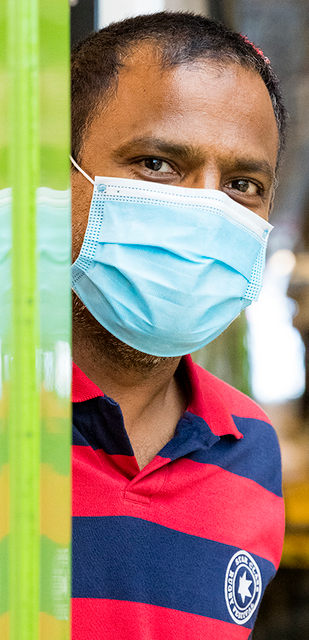 Go Transit customer S. Thiru, aboard a GO train. (Lorne Bridgman photo) As ridership increases and physical distancing becomes more of a challenge on our services, face coverings are critical in making people feel safer on their journey and limit the transmission of the virus. Metrolinx has made face masks mandatory. Their customers responded as the good partners they are and most have been wearing their face coverings or non-medical masks faithfully.
There are other equally necessary measures. Continue to stay home if you are sick or think you’ve been exposed. Get tested. It’s easy, just a wee bit uncomfortable in the nose region, and testing is readily available and quick.
Aikins adds: “I hate to burst your bubble, but please choose how many you let into your circle judiciously. You don’t want that moment of glory, of reconnecting with friends, to become regretted and a cautionary tale for others.
“Keep everyone outside your circle at a distance, six feet away specifically whenever possible.
“Wash your hands frequently. Scrub them like you just picked up your pooch’s poo. That works for me better than the birthday song. Use hand sanitizer too — you can find it everywhere now. Keep some in your purse or jacket and throw in some disinfecting wipes. It’s often as easy as toilet paper to find in stores now.
“As you open up your social bubbles, keep your visiting outdoors. Enjoy the nice weather. It’s good for the soul. And the fresh air reduces the virus’ ability to spread.
“As horrific as the tally of illness and deaths has been, the losses could have been so much higher if not for your commitment to protecting public health throughout this pandemic.
“You saved lives.
“Now is the time to double down in your resolve. The celebrations, the public good-byes and the healing will come in time.”
This article draws liberally from a piece written by Anne Marie Aikins, Metrolinx senior manager, Media.

 By Pepper Parr By Pepper Parr
August 4th, 2020
BURLINGTON, ON
He may not have a seat in the Legislature but Steven Del Duca, Leader of the Ontario Liberal Party, is playing political hardball and using the returning students to school issue as the baseball bat with which he is battering the Premier.
Last week he put forward a plan to get the schools opened opened in September that put student safety at the top of the list.
This week he is calling what the province announced on Thursday as the Premier’s “half-baked plan to reopen schools” which Del Duca claims “is nothing short of a catastrophe for parents, students, and teachers. The plan falls short of even the basic standards set out by Sick Kids and blatantly ignores recommendations from school boards, teachers, education workers, healthcare associations, and parents.
“Parents in Halton have been waiting anxiously for a plan to reopen schools safely – Doug Ford gave them one written on the back of a napkin,” said Del Duca. “None of the concerns parents raised have been addressed. None.”
Doug Ford’s school reopening plan gets a failing grade on every measure. The SickKids’ report, released last week, makes it clear that a proper plan must include smaller class sizes and a significant amount of new caretakers (custodians and cleaning staff).
“The Ontario Liberal Party took this advice seriously and, in consultation with experts in health care and education, released their Plan to Help Our Students last week.
 Steven Del Duca, Leader of the Liberal Party in Ontario “To reopen safely, the Liberal plan would fund 650 new classrooms in Halton, which are necessary to allow for physical distancing. Under Doug Ford’s Conservatives, there will be no new spaces at all.
“The Liberal plan would also support 710 new teaching positions in Halton to help keep class sizes small. Doug Ford’s plan only supports 14.
“To keep classes and schools clean, the Liberal plan would also create 320 new caretaker positions in Halton. The Conservatives will only create 36. That’s about 1 for every 3 schools.
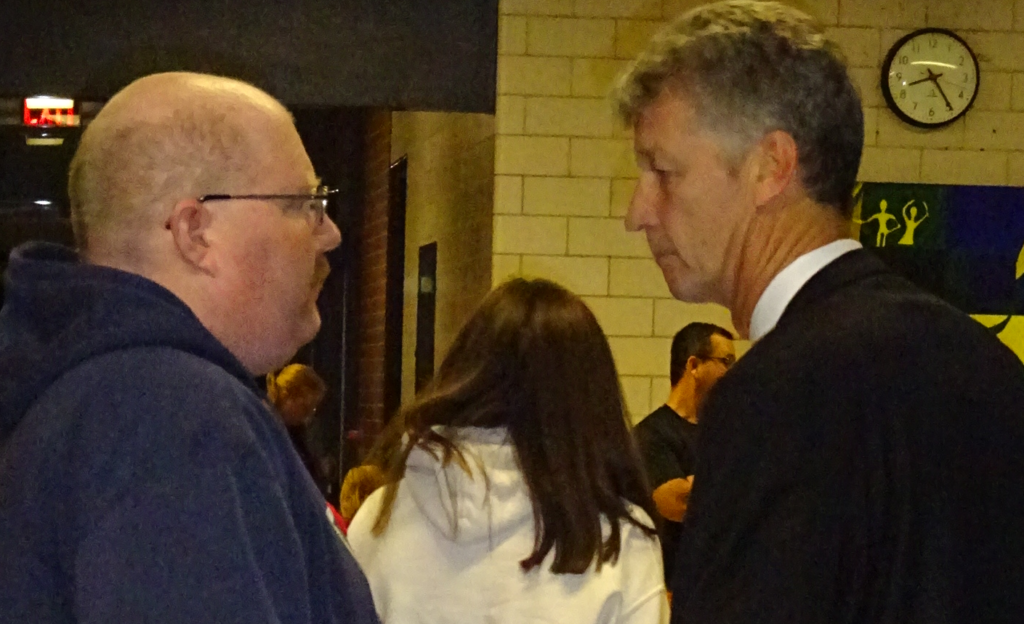 Director of Education Stuart Miller facing an irate parents during the Central School closing issue. Central prevailed and is still open. Del Duca adds that: “This plan continues to make it clear that Doug Ford is treating our students, their parents and everyone involved in the public education system as an afterthought. What Doug Ford gave us isn’t a plan to safely reopen schools – what he gave us was irresponsible. It doesn’t provide the smaller class sizes we need or enough resources to keep schools clean. It’s a dangerous roll of the dice with our kids’ safety.”
What Del Duca doesn’t include in his plan is where is anyone going to find the 650 classrooms that he maintains are needed. The space just doesn’t exist. As for the number of teachers – the Halton Board does not as yet know how many of the existing teachers are going to opt to return to a classroom.
Halton District School Board Director of Education Stuart Miller is surveying the teacher compliment to determine how many are not prepared to go into classrooms. Miller has said that he believes there are enough supply teachers who will teach in classrooms.

 By Staff By Staff
August 3, 2020
BURLINGTON, ON
The Halton Public Health Unit has created a “dashboard” that gives you an instant look on what has taken place in terms of COVID19 infections.
You can access the dashboard board HERE.
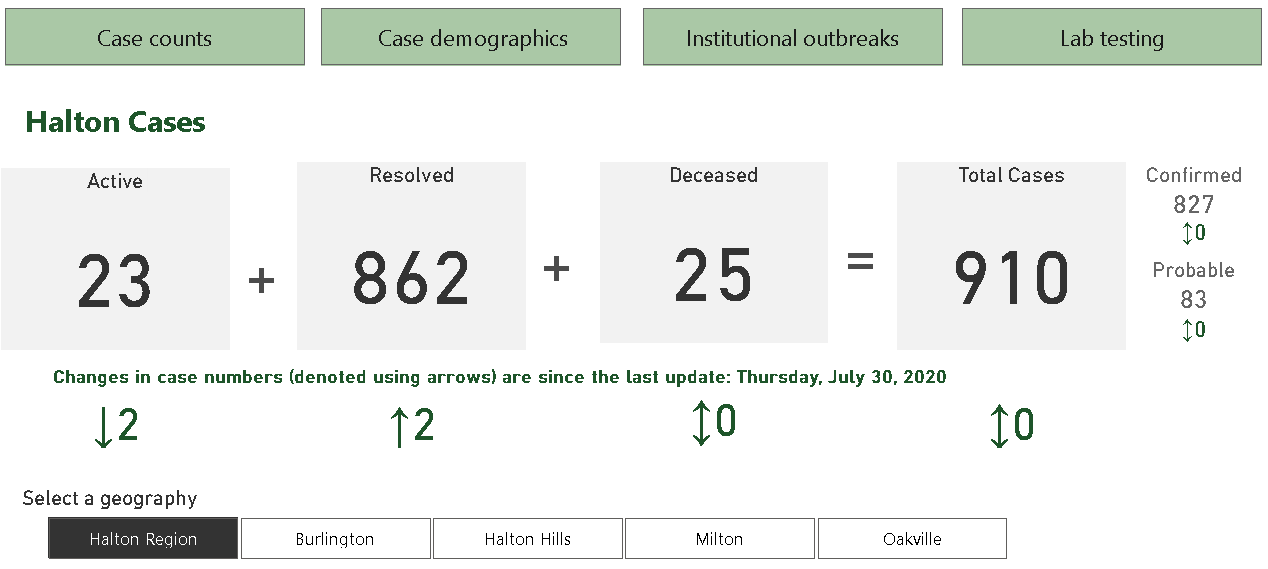 For a quick look at the COVID19 numbers for the Region – you can drill down to your community – the dashboard is a useful information source. Halton’s new interactive COVID-19 dashboard provides a summary of the current local situation and incorporates core epidemiological indicators of COVID-19 activity in Halton to date. Dashboard users can explore Halton’s COVID-19 data on overall case counts, case demographics, institutional outbreaks and lab testing.
As of July 17, Halton Region Public Health is currently in the process of adopting a new provincial COVID-19 database. During this transitional period, all counts should be considered preliminary and are subject to change as information is reconciled.

 By Pepper Parr By Pepper Parr
August 3rd, 2020
BURLINGTON, ON
We are on the last day of a long weekend that has given us more rain than we expected.
People able to get out on the Saturday but come the evening the rains came and kept us wet for much of Sunday.
Last Friday we saw the updates of COVID-19 infection data from the Regional Medical Officer of Health. The numbers were acceptable. Now that we are in Stage 3 where people can move about much more – go into restaurants and gather in larger groups, we are about to be tested on just how disciplined we are going to be able to be.
 A graphic depiction of the virus. The virus is in the community – do we maintain individual personal discipline and wear face masks while outside, wash our hands frequently and maintain that six foot thing when we are amongst people we don’t know?
For a feature that explain just how this virus infect us CLICK HERE.
How well we do will show up in the Public Health numbers in a week to ten days. So we wait.
The Public Health numbers as of the 29th of July are set out below.
In Halton, made up of Burlington, Oakville, Milton and Halton Hills the total number of COVID-19 cases amount to 910, – 827 confirmed + 83 probable.
24 cases currently active among Halton residents – 22 confirmed + 2 probable.
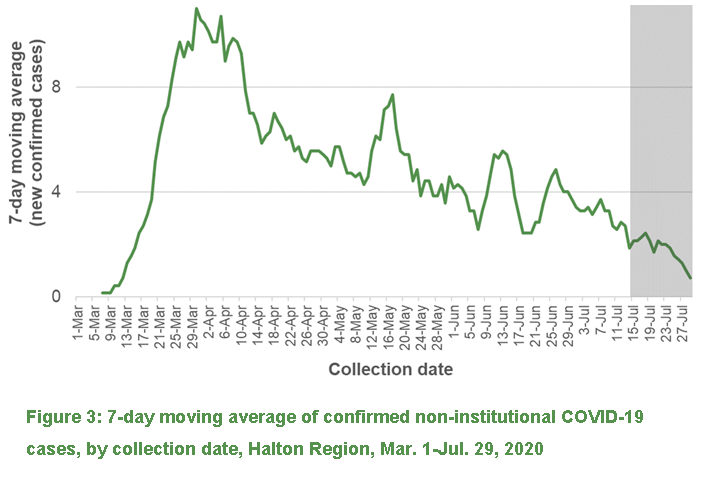
All cases have been graphed according to their episode date, which is used to estimate the date that symptoms began. Counts for the past 14 days should be interpreted with caution (indicated using the grey shaded area on the graph), since there is a delay between when a person becomes infected and when they develop symptoms, get tested and are reported as a case.
Probable cases are individuals presumed to have COVID-19 because they have symptoms of COVID-19 and are travelers returning from an affected area, have had close contact with a confirmed case, lived/worked in a facility experiencing a COVID-19 outbreak, or have indeterminate test results.
For each day, Figure 3 shows the average number of new confirmed COVID-19 cases over the past seven days, including only those cases that are not staff or residents/patients associated with an outbreak in an institutional or congregate care setting. Cases have been graphed according to their collection date, which is the date that a sample was taken from them to be tested for COVID-19. The graph suggests that the average number of new cases per day was highest in late March/early April, with another increase in mid-May. Counts for recent days should be interpreted with caution (indicated using the grey shaded area on the graph), since there is a delay between when a person is tested and when their test results are reported to Public Health and entered into the system.
Residents or patients of an institution experiencing an outbreak made up 9% of all cases – 79 people. 114 cases were people who worked in health care – 13% of all cases.
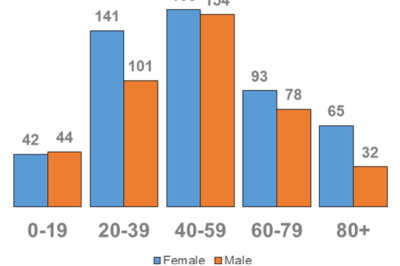 Infections by age and gender; This is no longer a virus that attacks just the elderly Figure 4 shows that by end of the day on July 29, the most COVID-19 cases were among Halton residents aged 40-59 (with 312 cases, or 34%). 499 cases (55%) were female. Two cases with unknown sex are excluded from the graph.
Females have outnumbered the males in terms of who got infected.
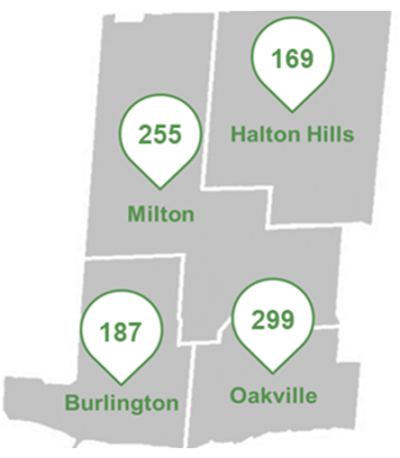 Figure 5 – infections by municipality. Figure 5 shows that by end of the day on July 29, the greatest number of COVID-19 cases were among residents of Oakville (with 299 cases, or 33%).
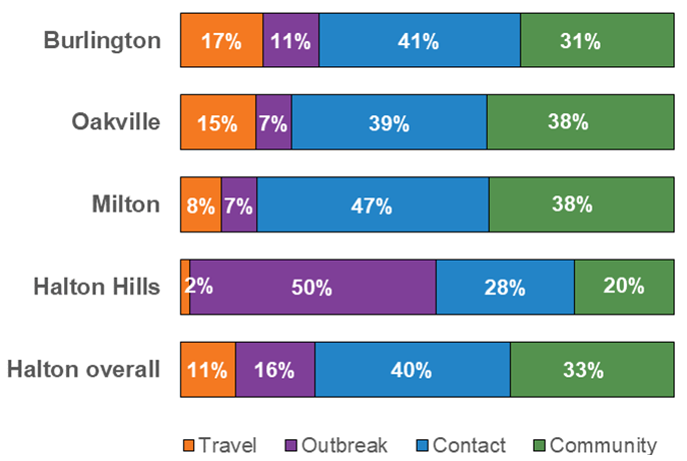 Figure 6: Where the public health people determined the infection came from. Figure 6 shows the percentage of COVID-19 cases by primary exposure category for Halton’s four municipalities and for Halton overall. For Halton overall, by end of day on July 29, 359 cases (40%) had contact with a confirmed case that was believed to be the source of their infection. 300 COVID-19 cases (33%) had no known travel or contact history, and therefore were believed to have acquired the virus within Ontario, making them community cases. 145 (16%) were residents/patients or staff associated with an outbreak in an institutional, congregate care, or workplace setting. 100 cases (11%) had a history of travel that was believed to have been the source of their infection. These proportions vary by municipality, and six cases with exposure information pending have been excluded.
It is important to note that cases can have multiple exposures, and these data reflect only their primary exposure category based on information gathered during case investigation.
Case and contact follow-up
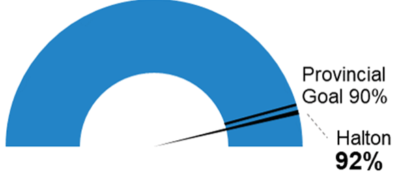 Figure 7 shows that 100% of Halton cases reported over the past seven days (Jul. 23-28) were reached by Halton Region Public Health within one day of being reported, which exceeds the provincial goal of 90%. Figure 8 shows that Halton Region Public Health reached 92% of contacts identified over the past seven days (Jul. 23-28) within one day, compared to the provincial goal of 90%. Figure 7 shows that 100% of Halton cases reported over the past seven days (Jul. 23-28) were reached by Halton Region Public Health within one day of being reported, which exceeds the provincial goal of 90%. Figure 8 shows that Halton Region Public Health reached 92% of contacts identified over the past seven days (Jul. 23-28) within one day, compared to the provincial goal of 90%.
It is important to note that Public Health attempted to reach 100% of cases and community contacts within one day but in some cases could not reach the client within that time span. Common reasons for not reaching clients within one day include incorrect phone number provided or client did not respond to repeated contact attempts.
Case outcomes
99 cases have ever been hospitalized to date – four are listed as currently in hospital.
861 cases have been resolved; 25 people have died to date (12 of the deceased were residents or patients of an institution experiencing an outbreak)
Institutional outbreaks
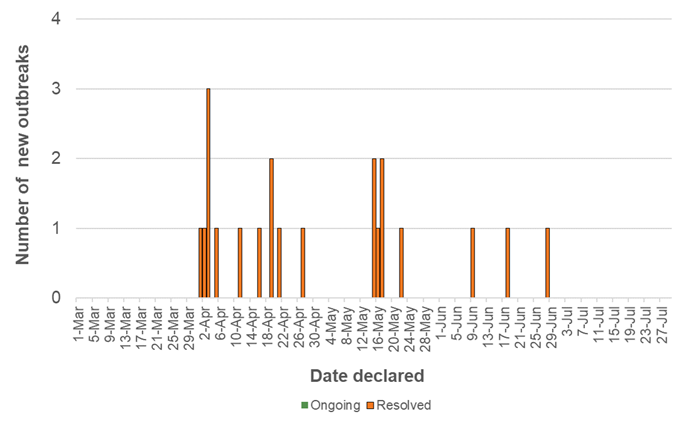 Figure 9 shows the 21 confirmed outbreaks of COVID-19 in Halton institutions reported by end of the day on July 29. Institutions are defined as long-term care homes, retirement homes and hospitals. All 21 of the outbreaks have resolved. Among the 21 confirmed institutional outbreaks reported to date, 13 (62%) have been in long-term care homes, seven (33%) have been in retirement homes and one (5%) has been in a hospital. Figure 9 shows the 21 confirmed outbreaks of COVID-19 in Halton institutions reported by end of the day on July 29. Institutions are defined as long-term care homes, retirement homes and hospitals. All 21 of the outbreaks have resolved. Among the 21 confirmed institutional outbreaks reported to date, 13 (62%) have been in long-term care homes, seven (33%) have been in retirement homes and one (5%) has been in a hospital.
Lab testing
>4,380
Halton residents were tested for COVID-19 within the past seven days of available data (Jul. 19-25)
>53,120
Halton residents are known to have been tested for COVID-19 to date
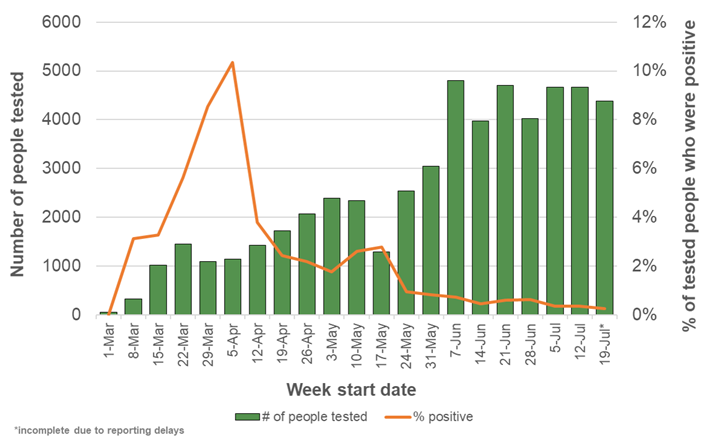 Figure 10″ The number of people tested and the percentage that were found to be positive. The green bars in Figure 10 show the number of Halton residents who were tested for COVID-19 each week, beginning the week of March 1-7. Data for the most recent week (Jul. 19-25) is incomplete due to reporting lags. The number of people tested decreased the week of May 17 compared to past weeks as mass testing of institutional residents was completed. The number of people tested then began to increase again, as the provincial government permitted more widespread testing.
The orange line in Figure 10 indicates the percentage of tested Halton residents who were positive for COVID-19. The percent positivity was highest the week of April 5-11, when 10.3% of Halton residents who were tested for COVID-19 had positive results. In the most recent week (Jul. 19-25), 0.3% of people tested for COVID-19 tested positive, although this number is subject to reporting delays.
Data limitations and Data sources
Halton case data: Case and Contact Management system (CCM), extracted at 7:00 AM on July 30, 2020, to reflect data entered by the end of the day on July 29, 2020
Halton lab testing data: Institute for Clinical Evaluative Sciences, Number of individuals who were confirmed positive for COVID-19, COVID-19 Testing Period: 15 Jan 2020 to 25 July 2020. Received on July 28, 2020.
Ontario case counts: Public Health Ontario, Epidemiologic Summary, COVID-19 in Ontario: January 15, 2020 to July 29, 2020, posted on July 30, 2020 to https://www.ontario.ca/page/2019-novel-coronavirus.
Denominators for Halton and Ontario age-specific rates: Population projections [2020], IntelliHEALTH Ontario, extracted on April 8, 2020.
Data notes
CCM is a dynamic disease reporting system which allows ongoing updates to data previously entered. As a result, data extracted from CCM represent a snapshot at the time of extraction and may differ from previous or subsequent reports. The data only represent cases reported to public health and recorded in CCM. As a result, all counts will be subject to varying degrees of underreporting due to a variety of factors, such as disease awareness and medical care seeking behaviours, which may depend on severity of illness, clinical practice, changes in laboratory testing, and reporting behaviours.
Figures 1 and 2 distinguish between lab-confirmed and probable cases. Probable cases are individuals presumed to have COVID-19 because they have symptoms of COVID-19 and are travelers returning from an affected area, have had close contact with a confirmed case, lived/worked in a facility experiencing a COVID-19 outbreak, or had indeterminate test results.All other figures and numbers include both confirmed and probable cases combined, except Figure 3, which uses confirmed cases only.
All data includes only individuals whose main usual residence is in Halton Region. Cases who have municipality information pending are excluded.
Active cases, resolved cases and deaths are a subset of total cases.
• Cases are considered to be active if the case is open in CCM and not listed as resolved.
• Case outcomes (resolved, deaths) reflect the latest available information reported to Halton Region Public Health and recorded in CCM by the extraction time.
• Resolved cases are persons who have been discharged from isolation at 14 days after symptom onset if they did not have a fever and their symptoms were improving for at least 72 hours OR 14 days from when they were tested if they were asymptomatic. For cases with no significant improvement in symptoms, Public Health continues monitoring until the case meets resolution criteria and the case is closed in CCM. For cases in hospital, a test-based approach may be used and isolation is continued until 2 consecutive negative tests are obtained, at least 24 hours apart.
• Deaths include any death that occurred among a person who tested positive for COVID-19, even if the death may not have been directly attributable to COVID-19.
In subsequent reports, counts in Figures 1-3 may increase as cases are added from past dates as individuals become symptomatic, get tested, and their results are reported to Halton Region Public Health, as well as any past results are added due to delayed data entry or new arrival of lab results.
Cases are considered to be patients or residents of an institution experiencing an outbreak if they are linked to a confirmed Halton institutional outbreak in CCM, and they are not known to be a staff person at the institution.
Cases are considered to work in health care if they are known to have an occupation that involves caring for patients, e.g. physician, nurse, occupational therapist, recreational therapist, chiropractor, paramedic, midwife, orderly, etc. Individuals who work in health care settings but do not provide direct care to patients (e.g. managers, cleaning staff) have not been included.
Exposure type is determined by examining the risk factor fields in CCM to determine whether a case travelled, was a resident/patient or staff member in an institution/congregate care setting/workplace experiencing an outbreak inside or outside Halton, was a contact of a case or neither. A hierarchy has been applied as follows:
• Cases with episode date before April 1: Travel > Associated with any type of outbreak (institutional, congregate care, or workplace) in or outside of Halton > Close contact of a confirmed case > None of the above (indicating community acquisition) > Information pending.
• Cases with episode date on or after April 1: Associated with any type of outbreak (institutional, congregate care, or workplace) in or outside of Halton > Close contact of a confirmed case > Travel > None of the above (indicating community acquisition) > Information pending.
It is important to note that cases can have multiple exposures, and these data reflect only their primary exposure category.
Differences between municipalities have not been assessed for statistical significance. Known cases reflect only individuals who were prioritized for testing prior to the expansion of testing in May, which means that differences between municipalities are currently difficult to ascribe to other factors.
Cases are considered to have been reached within 24 hours if their investigation start date and case reported dates in CCM are no more than one day apart.
Contacts are considered to have been reached within 24 hours if their interview completion date and reported dates in CCM are no more than one day apart.
Our main priority in outbreak management is prevention. Ensuring appropriate measures are being taken by the institutions requires time, in addition to collecting information on the status of the residents. Institutional outbreaks include outbreaks of COVID-19 in settings such as long-term care homes, retirement homes, hospitals and prisons. Outbreaks in congregate care settings (e.g. group homes) and workplaces are not included. Date declared for outbreaks reflects the outbreak classification date in CCM.
Lab testing data reflects only lab tests that have been assigned to Halton Region based on the methodology used by the Institute for Clinical Evaluative Sciences. There are several known limitations associated with this data:
• The unit of analysis is the testing episode (unique individuals tested per day). Individuals tested multiple times on different days are counted once in each week’s counts for the appropriate weeks. Testing episodes after the individual’s first confirmed positive COVID-19 test were excluded from subsequent weekly counts (numerator and denominator).
• The COVID-19 test results were captured in the Ontario Laboratories Information System (OLIS). The testing date represents the date of specimen collection: “observation date” in OLIS. Due to the time required for transportation and processing of specimens, it takes six days for approximately 95% of results to be finalized and reported for a given testing date. Some laboratories did not report all or part of their COVID-19 test results to OLIS. Unconsented test results were excluded;
• Counts less than six are suppressed;
• The location of tested individuals was based upon the test recipient’s postal code (and corresponding health unit) recorded in the OHIP Registered Persons Database (RPDB) for those residing outside a long-term care (LTC) facility, and the LTC address on the OLIS test requisition for specimens collected from LTC facilities. These address assignments lead to misclassification of PHU in approximately 14% of individuals
Data later
New Interactive Halton COVID-19 Dashboard:
Halton’s new interactive COVID-19 dashboard provides a summary of the current local situation and incorporates core epidemiological indicators of COVID-19 activity in Halton to date. Dashboard users can explore Halton’s COVID-19 data on overall case counts, case demographics, institutional outbreaks and lab testing. The dashboard can be accessed at halton.ca/covid19.
Also, please note that as of July 17, Halton Region Public Health is currently in the process of adopting a new provincial COVID-19 database. During this transitional period, all counts should be considered preliminary and are subject to change as information is reconciled.

|
|
 By Pepper Parr
By Pepper Parr

















 This year, Burlington Lions Club invested over $4,000 in boundary fencing, signage, PPEs, sanitizers, and access controls to obtain clearance from public health authorities to operate this unique open-air venue. This cost has not been passed on to the vendors or the customers – the Lions consider it an important investment, as a service to the community. Also, additional volunteer staffing has been required to set up and take down the market, and monitor safe distancing practices of vendors and staff.
This year, Burlington Lions Club invested over $4,000 in boundary fencing, signage, PPEs, sanitizers, and access controls to obtain clearance from public health authorities to operate this unique open-air venue. This cost has not been passed on to the vendors or the customers – the Lions consider it an important investment, as a service to the community. Also, additional volunteer staffing has been required to set up and take down the market, and monitor safe distancing practices of vendors and staff.

















 “Our ability to communicate with the members of our community is absolutely essential,” says Halton Regional Police Service Deputy Chief Roger Wilkie. “With guidance and input from the Bob Rumball Canadian Centre of Excellence for the Deaf, we have now removed a significant communications barrier.”
“Our ability to communicate with the members of our community is absolutely essential,” says Halton Regional Police Service Deputy Chief Roger Wilkie. “With guidance and input from the Bob Rumball Canadian Centre of Excellence for the Deaf, we have now removed a significant communications barrier.”





















 Haven’t heard of geometric progression? The explanation for the pattern of American infections lies in something of central importance to the spread of a virus: geometric progression, such as 1, 2, 4, 8, 16.
Haven’t heard of geometric progression? The explanation for the pattern of American infections lies in something of central importance to the spread of a virus: geometric progression, such as 1, 2, 4, 8, 16.















 Figure 7 shows that 100% of Halton cases reported over the past seven days (Jul. 23-28) were reached by Halton Region Public Health within one day of being reported, which exceeds the provincial goal of 90%. Figure 8 shows that Halton Region Public Health reached 92% of contacts identified over the past seven days (Jul. 23-28) within one day, compared to the provincial goal of 90%.
Figure 7 shows that 100% of Halton cases reported over the past seven days (Jul. 23-28) were reached by Halton Region Public Health within one day of being reported, which exceeds the provincial goal of 90%. Figure 8 shows that Halton Region Public Health reached 92% of contacts identified over the past seven days (Jul. 23-28) within one day, compared to the provincial goal of 90%. Figure 9 shows the 21 confirmed outbreaks of COVID-19 in Halton institutions reported by end of the day on July 29. Institutions are defined as long-term care homes, retirement homes and hospitals. All 21 of the outbreaks have resolved. Among the 21 confirmed institutional outbreaks reported to date, 13 (62%) have been in long-term care homes, seven (33%) have been in retirement homes and one (5%) has been in a hospital.
Figure 9 shows the 21 confirmed outbreaks of COVID-19 in Halton institutions reported by end of the day on July 29. Institutions are defined as long-term care homes, retirement homes and hospitals. All 21 of the outbreaks have resolved. Among the 21 confirmed institutional outbreaks reported to date, 13 (62%) have been in long-term care homes, seven (33%) have been in retirement homes and one (5%) has been in a hospital.




